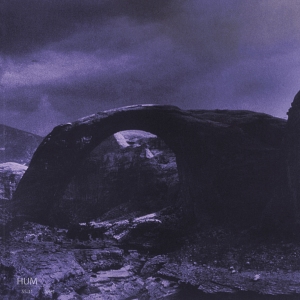
Roughly twenty-five years ago I taped a song off the radio, rewound endlessly to replay it, and then made it my mission to buy a copy of the CD during a high-school trip to Boston. I begrudgingly paid the outrageous sum of $17.99 for a copy of Hum’s You’d Prefer an Astronaut at the Tower Records in Harvard Square—it was out of stock at the nearby Newbury Comics—and, not yet owning a portable CD player, waited anxiously to get home so I could hear the rest of the album.
Over the next days, months, and years, I more than made up for that excruciating delay. I dubbed the CD to one side of a blank cassette and ground its fidelity to mush as I transported myself out of myriad high-school bus rides. The appeal of the introductory single “Stars” was twofold: its massive riffs were bracingly huge, bolstered by a steady undercurrent of compelling textures and melodic leads, but Matt Talbott’s vocals and lyrics eschewed the posturing attitude commonly associated with “heavy” music. The head-fake intro (memorably skewered by Butt-Head: “It sucked but at least it was short”) was quiet and thoughtful, and those qualities remained once the song fully kicked in. The rest of You’d Prefer an Astronaut spiraled out from this combination of overflowing guitars and ponderous, evocative lyrics. Its romantic notions were filtered through stargazing or space-bound narratives, and the album’s lingering threat is becoming untethered, both in literal and relational senses. Hum proved equally adept at meditative mid-tempos (the enveloping drone of “Little Dipper,” the psychedelic imagery and polychromatic tones of “Suicide Machine”), surging rockers (the dark intensity of “The Pod,” the soaring arcs of “I’d Like Your Hair Long”), and ambling odes (“Songs of Farewell and Departure”). You’d Prefer an Astronaut offered familiarity and escape.
You’d Prefer an Astronaut felt like a self-contained world, but after going online and finding their web page (http://www.prairienet.org/~hum/, flaunting a sub-directory and a tilde), I worked my way to Urbana, Illinois' Parasol Mail Order, which offered their earlier records, their t-shirts, related bands, and aesthetically similar bands. I learned how the band went through numerous personnel changes before recording its 1991 debut, Fillet Show, whose groaning pun of a title is an accurate indicator of its contents’ (cough) rather considerable room for growth. After guitarist Balthazar de Lay left to front his own band, Mother (later renamed Menthol), Hum finalized its lineup by adding the youthful Tim Lash on guitar and comparative veteran Jeff Dimpsey on bass (he’d previously played guitar in Champaign-Urbana mainstays the Poster Children and Hum’s brother band, Honcho Overload, alongside bassist Matt Talbott). Thanks to these new additions, 1993’s Electra 2000 was a significant step forward, worthy of being dubbed to the opposite side of my You’d Prefer an Astronaut cassette. Electra is a dynamic, bruising album, driven by the chugging riffs of highlights “Iron Clad Lou,” “Sundress,” and “Winder.” It’s jarring to work backwards to Talbott’s throat-shredding desperation, that approach having been whittled down to a single scream on You’d Prefer an Astronaut’s “The Pod,” and even on its best tracks, Electra 2000’s tonal palette is monochromatic. However raw and comparatively unpolished it may be, Electra 2000 still holds up, especially “Diffuse,” a compilation track added to the 1997 Martians Go Home! CD pressing.
The other breadcrumbs I followed proved that Hum did not exist in a vacuum, that You’d Prefer an Astronaut did not materialize out of thin air. Matt Talbott’s list of his favorite records on Hum’s page (from memory, a cross-selection of turn-of-the-decade indie/alternative guitar rock: Dinosaur Jr.’s Bug, The Flaming Lips’ In a Priest Driven Ambulance, My Bloody Valentine’s Loveless, and half a dozen others I’m less certain of, like Mercury Rev, Swervedriver, and Bitch Magnet) traced one side of their development, and the sonic similarities and shared members of various notable bands from Champaign-Urbana and other significant Midwest college towns tracked another. A communal affinity for thick guitar sounds could be found on Poster Children’s Daisychain Reaction (their lone album featuring Jeff Dimpsey and arguably their heaviest), Honcho Overload’s Pour Another Drink, Zoom’s self-titled debut (Matt Talbott is referenced by name on the jittery “Ephedrine Breakfast” from the band’s second LP, Helium Octipede), and Love Cup’s Greefus Groinks and Sheet (an album still discussed in hushed reverence by people who were there, and also me, who was not). Hum’s evolution from Fillet Show to Electra 2000 makes more sense when contextualized within a regional Midwestern sound. And if You’d Prefer an Astronaut used a major-label recording budget to realize a sound previously out of reach to the group, it’s noteworthy to Talbott’s list of favorites that Flaming Lips producer Keith Cleversley was at the helm.
Hum may have existed within a community of like-minds, but my high school provided no such comforts. No one in my social circle had any interest in going deeper into the alternative / indie waters, so band mailing lists and IRC channels were godsends. The members of Hum did not frequent the band’s semi-official listserv (leaving such future-signaling fan/band interactions to the Poster Children) or #hum (back when hashtags were associated with IRC channels), but I found plenty of great people in similar situations. Like a half-dozen others, I did my service by running a Hum fan site, collecting lyrics, photos, and links to supplement Hum’s skeletal web presence.
Hum’s next album, Downward Is Heavenward, didn’t come out until early 1998. Their perfectionist tendencies took precedence over striking while the iron was hot, and Downward was reportedly recorded twice: first with YPAA producer Keith Cleversley, then with Mark Rubel in Champaign. My previews came from the early demo of “Ms. Lazarus” on the CD5 for “The Pod” (a warm, unfussy run-through of an endlessly endearing track) and a third- or fourth-generation cassette of a live show featuring an embryonic version of “Comin’ Home” (not specifically this one, but here's another 1995 performance of it) which sounded far rawer in its infancy (and/or compromised fidelity) and offered an entirely different chorus (“I’ll treat you like a sound,” which I heard for years as “I’ll treat you like a son”). As the release date approached, fan sites got to post 30-second samples of songs—either in the streamable muck of the briefly in-vogue RealAudio format or the comparative clarity of the nascent, bandwidth-punishing mp3 format—and I obsessed over too-short tastes of “Dreamboat” and “Green to Me.” I ordered the vinyl from Parasol because it was coming out at least a week before the CD hit stores, and patiently waited for it to arrive.
Hearing Downward Is Heavenward for the first time was vastly different from my initial spin of You’d Prefer an Astronaut; I had expectations, I’d heard plenty of other excellent bands and records in the intervening years, and my listen was tempered by the group-think of an internet community. I loved it, but my appreciation wasn’t unqualified. The production sheen felt too glossy in comparison to the mid-fi warmth of You’d Prefer an Astronaut. Not every song clicked immediately (looking at you, “The Scientists”). My hopes for a blistering “Comin’ Home” and an enveloping, intimate “Ms. Lazarus”—what I’d already heard, essentially—were dashed. Those hints of resistance, of grasping onto how much my decaying cassette dub of You’d Prefer an Astronaut meant to my bus rides, were on me, not the band. Eventually I got over it with the help of an eardrum-punishing performance at Irving Plaza in New York City (during my moronic phase of being Too Cool for Earplugs), and I could appreciate Downward Is Heavenward for being different from You’d Prefer an Astronaut. The depth of “Isle of the Cheetah” was like a time-lapse video of organic life taking hold of an abandoned structure. “Ms. Lazarus” needed the extra oomph to fully surge in its final section. “Afternoon with the Axolotls” (though lacking its superlative live intro) was thoughtful and explorative. The double-punch of romance and riffs provided by “Dreamboat” and “The Inuit Promise” made me long for the chance to meet new people I might actually connect with. The deftly recorded reverb of “Apollo” made its ache that much more powerful.
Downward Is Heavenward didn’t come close to replicating the commercial success of You’d Prefer an Astronaut. The sci-fi video for lead single “Comin’ Home” was rejected by MTV’s 12 Angry Viewers, one of the network’s shows designed to combat the (accurate) criticism that it aired a diminishing selection of music videos, and second single “Green to Me” gained no traction. The tides were against them: “alternative rock” skewed more and more “pop” (big singles that year included Semisonic’s “Closing Time,” Barenaked Ladies’ “One Week,” and The Offspring’s “Pretty Fly [For a White Guy]”); nu-metal was on the rise with the multiple-platinum success of Korn’s Follow the Leader; and Total Request Live pushed the most popular videos to even greater ubiquity. Meanwhile, Hum’s van was wrecked during a June tour through Canada, forcing the cancellation of most of the remaining dates. The band sounded exhausted in interviews, fully aware of the writing on the wall.
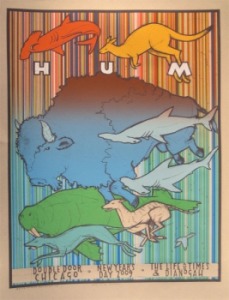
Hum never released an official statement about breaking up or going on hiatus, but after only playing one show in 1999 and two in 2000, they entered cryo-sleep following an opening slot for The Flaming Lips’ New Year’s Eve show at the Metro in Chicago. The members went their separate ways: Matt Talbott formed Centaur with Castor bassist Derek Niedringhaus and drummer Jim Kelly; Tim Lash started Glifted with Love Cup’s T.J. Harrison; Jeff Dimpsey revived the whispered-about Champaign group National Skyline with Castor’s Jeff Garber; and Bryan St. Pere moved to Indiana for a pharmaceutical job. Centaur and Glifted bifurcated Hum’s DNA for their respective 2002 albums. Centaur’s In Streams took a mournful approach to Hum’s foundations, repeating its big riffs over Matt Talbott’s reserved vocals. (I saw Centaur a number of times, but their curtailed opening set for Shiner in St. Louis is seared into my brain, specifically Talbott sighing “Our band is in this [malfunctioning] pedal” while nursing a comically huge bottle of beer.) Glifted’s Under and In emptied a warehouse of head-spinning metallic shoegaze riffs, with the surprising addition of falsetto vocal hooks on some songs. But each band possessed what the other lacked: Centaur needed Tim Lash’s inventive guitar parts to break the repetition, while Glifted needed Matt Talbott’s emotional resonance and structural support to channel great parts into great songs. Dimpsey’s National Skyline was the best of these projects, particularly their 2000 self-titled EP and 2001’s This = Everything, which simultaneously looked back to U2’s The Unforgettable Fire and ahead to the icy, electronic-bolstered post-emo of groups like Antarctica. But Dimpsey never toured with National Skyline, and that group, too, went on hiatus during Garber’s move to Los Angeles to join Failure’s Ken Andrews in Year of the Rabbit (and later form The Joy Circuit). A second wave of projects appeared in the late ’00s, with Tim Lash forming Balisong and Alpha Mile (no studio recordings, but live footage exists for the latter) and Jeff Dimpsey teaming with Absinthe Blind’s Adam Fein for Gazelle, releasing Sunblown in 2008.
Even in ostensible hiatus, Hum still emerged every few years. Furnace Fest called their asking-price bluff in 2003, and their headlining set was preceded by a local warm-up in Champaign. Sporadic regional dates occurred in 2005 and 2008–2009 (I saw their New Year’s Day show in Chicago), picking up in 2011 around the time of the FunFunFun Festival. Two unreleased songs—“Inklings” and “Cloud City”—frequented their sets at these shows, and I attempted to will a seven-inch with studio recordings into existence. A co-headlining tour with Failure in 2015 marked the most significant action since the release of Downward Is Heavenward. Bryan St. Pere opted out of this tour, aptly replaced by Shiner’s Jason Gerkin, and a year later, the band confirmed that they were working on new material. The still-unreleased “Voyager 1” started appearing in 2016. When I saw them (with St. Pere back in the band) in St. Louis in early 2018 (sharing a bill with a reunited Castor!), they unveiled a few new-new songs: “Folding,” “The Summoning,” and an instrumental version of “In the Den,” none of which felt fully formed yet.
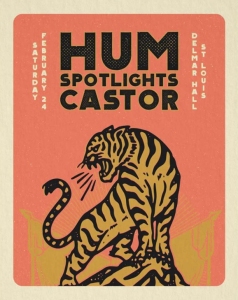
The idea of Hum releasing new material was always within the realm of possibility, but turning that promise into actuality was a harder proposition to grasp. Given that Matt Talbott owns and operates his own studio (Earth Analog in Tolono, IL, formerly known as Great Western Record Recorders), the logistics for recording were mostly handled. But the band’s timetable-tipping perfectionism made any hypothetical release date seem impossibly optimistic. Said trait dates back to both of their RCA albums, but resurfaced more recently with regards to vinyl reissues. Talbott was understandably miffed at ShopRadioCast having snaked the reissue rights for You’d Prefer an Astronaut in 2013 and not involving the band in the (assuredly CD-sourced, decidedly shitty) pressing. So the 2LP reissue of Downward is Heavenward opted against a cash-grab rush-job and for an extraordinarily patient, results-oriented process. After years of rejected test pressings and other delays, it finally came out in 2018 on Talbott’s own Earth Analog Records (the second pressing on blue vinyl appears to still be available), and was worth every penny. Whereas the original pressing crammed too much music onto a single LP, the reissue gave the songs room to breathe, and the new mastering job added depth and clarity. Adding “Puppets,” “Aphids,” and “Boy with Stick” as bonus tracks on the fourth side was greatly appreciated. The end result was worth the wait, but it didn’t exactly give hope that the new Hum album would appear anytime soon, even with rumblings that “it’s done except for a few vocals.” An added wrinkle came with the news that Talbott was working on a solo album to complement his living room tours (remember touring?), an album that might somehow come out before the Hum record. Early versions of “Sinister Webs” and the sprawling drone “Way Up Here” popped up on Bandcamp, giving the project the proof of life.
And then that mythic new Hum album just… appeared. Inlet was surprise-released on June 23, 2020 on Bandcamp and presumably also lesser digital outlets, and the Earth Analog–pressed vinyl was available for preorder through Polyvinyl (a wise choice after the early blink-and-you-missed-it drops of the Downward Is Heavenward reissue brought both Talbott and eager fans much consternation). It was a blinding ray of sunlight amidst the endless drudgery of quarantine life, a bona fide event to make up for the fact that calendars had been wiped clear for months. Texts were sent and received as I carved time out of my child-watching schedule to actually listen to the album. Around that time the chatter switched from “whoa there’s a new Hum album” to “whoa the new Hum album is great.”
And it is great.
Inlet’s surprise drop reversed my expectations-burdened introduction to Downward Is Heavenward. Even with the knowledge that Inlet would arrive at some point, the twenty-two years of distance from Downward and all of the offshoot projects—satisfying, underwhelming, and forgotten alike—wiped the slate clean for both this fan and the band. I wasn’t paralyzed by comparing subjective quality, while Hum weren’t boxed in for their next moves. I’ve seen a few people assert that Inlet could have easily come out a year or two after Downward and I respectfully disagree; the ways in which Hum’s sound and perspective have shifted depend on that timeframe. The songs are longer, with stretches of meditative repetition drawn from stoner/doom metal. Matt Talbott’s lyrics largely trade the brightness of Downward highlights like “Dreamboat” for a lived poetic perspective on his fleeting place within nature, within humanity, within the galaxy, like Mount Eerie’s Phil Elverum writing bittersweet sci-fi memoirs. Inlet isn’t disconnected or displaced from the continuity of Electra 2000, You’d Prefer an Astronaut, and Downward Is Heavenward—there are riff-churning, melodically buoyant tracks here, don’t worry—but like Polvo’s return albums In Prism and Siberia, Inlet exhibits a band that did not stop evolving, even if the signposts of studio recordings did not appear to document that journey.
The eight tracks on Inlet sift into three different modes: mid-tempo melodic rockers, ultra-heavy evocations of stoner metal, and ponderous, introspective odes. The first category is the most populous, offering “Waves,” “In the Den,” “Step into You,” and “Cloud City.” (“Inklings” is curiously absent from Inlet, perhaps viewed as remnant of Downward instead of a step forward.) As much as I’ll argue that Inlet doesn’t exclusively traffic in the nostalgic thrall of a classic sound captured in amber, there’s no denying the dopamine rush of that guitar sound when the post-Loveless arcs of “Waves” hit. Those layers of immaculately crafted guitars offer an immediate, resuscitative balm, continuing to reveal new overdubs on the tenth, fifteenth, twentieth spin. “Waves” looks back upon past, unspoken struggles (“They don’t know of my solitary days”) as Talbott gazes off into an uncertain future, but there’s a comforting serenity to this distanced perspective as the song churns and crests, closing with “To see beyond the boiling sun / To the other side / And the wonders didn’t end.” The lack of an emphatic, hooky chorus in “Waves” (an element Hum deprioritizes for much of Inlet) is quickly rectified by “In the Den,” which offers the album’s most catchiest refrain. It’s hard not to appreciate “I am still alive and what's coming true / Is the signal to my return, oh! / Find me here on the ground and in need of you” as a meta-level statement on Hum’s reappearance, and the liveliness of that “Oh!” cannot be understated. If Inlet came out on a major label, there would assuredly be a single edit for “In the Den,” which rides its soaring riff almost seven minutes before fading out, but Hum’s propensity for savoring its work doesn't tip against the listener’s favor. “Step into You” is Inlet’s shortest song at just over four minutes and its most conventionally structured, switching between a satisfyingly chunky verse riff, a slowed-down chorus progression, and a silvery guitar solo. In contrast, “Cloud City” lets its sci-fi tinged verses (“Crowds would gather on the traces of the outer rings”) give way to the tremendous gravitational pull of the guitar workout black-hole where a chorus might have once lived, fueled by Bryan St. Pere’s best, most pummeling work on Inlet.
While those four songs offer a comfort-food buffet for starving Hum fans, “Desert Rambler” and “The Summoning” expand the menu’s offerings. The stylistic stamp of stoner/doom metal on Inlet is not without precedence: Matt Talbott’s bar Loose Cobra in Tolono, IL, has hosted Oktstoner Festival, and it’s a natural progression from the skeletal riff-and-repeat approach of Centaur’s songs. I recall being at Parasol after Centaur had played a show in Chicago with Pelican (having just released their untitled debut EP) and drummer Jim Kelly sang the band’s praises. It wasn’t a one-way relationship—the leads of the title track to City of Echoes demonstrate how much Pelican drew from Hum—and it’s on these songs that Hum reflects back upon some of the bands they influenced and remain within their orbit, whether that’s the continent-shifting churn of early Pelican, the metal-tinged instrumental rock of Ring, Cicada offshoot Dibiase (who’ve released an EP and an LP on Talbott’s Earth Analog Records), or the heavy slow-core group Cloakroom (who chose Talbott to produce their 2015 LP Further Out and got him to sing lead vocals for their b-side “Dream Warden”). “Desert Rambler” spans nine minutes, alternating between a mammoth verse riff that Talbott nearly has to bellow over and dreamy, barren bridges and choruses. Even before chiming notes swoop over the top of the machinery, there’s a impressive build-up of undercurrent textures (to the mystifying chagrin of the otherwise satiated Stephen Malkmus, a comment which at last connected my high-school fondness of both Hum and Pavement). “The Summoning” is somehow heavier and slower (who do they think they are, Pinebender?), but even with the foreboding crush of its main riff and the serrated edge of the harmonic accents, Talbott’s sheepish nature (“Let this be the last assumption that you were never wrong / I am ever wrong”) and detached perspective (“Just a twist and I'm gone / Through the ether and on to home”) offer a variation on the juxtaposition between form and content that initially drew me to Hum’s music. Given how Hum’s aesthetic leap on Electra 2000 was driven by predecessors and peers, adding the influence of their protégés on “Desert Rambler” and “The Summoning” while still scanning as Hum songs feels fitting.
Inlet’s final two songs are my clear favorites on the record, applying the analgesic guitar tones of the up-tempo tracks to the sprawling terrain of the Mesozoic stompers, and uncovering new lyrical depth in the process. “Folding” and “Shapeshifter” each stretch to eight minutes, hinging upon a very relatable combination of overwhelmed by what might come next and comforted by the lasting resonance of his loving relationship. “Folding” weaves a melodic lead around Talbott’s ponderous verses—“Do you feel tremors here? / Do you feel the same like you used to?”—then lets Jeff Dimpsey’s undulating bass line take hold before asserting “I could never be two / I’ve got it in for you” in the shimmering coda. The last two minutes of “Folding” quietly pulse as delay-drenched scrapes curl overhead, a ruminative enclave before Inlet’s closing track. “Shapeshifter” allows its evocative guitar line to play out in full before Talbott’s vocals come in, and there’s no better encapsulation of his lyrical appeal than its opening verse:
I remember the skies and the sand
I remember your face and your lovely hand
Words poured out on a dusty land
And gravity comes to us all
I feel the engines stall
Feel us start to fall
The chorus of “Shapeshifter” elongates its syllables into an immersive wash, floating over a slow-moving sunset. The bittersweet bridge—“While you let the water in / I dreamt again that I couldn’t swim”—builds into a C-Clamp-esque plateau of sustained guitar, and then switches to the cleaner chords of the song’s back half. The titular shapeshifting occurs as Talbott envisions himself as a butterfly, a fawn, and a bird, a fanciful sequence motivated by “Finding myself past the half-life of me” and pondering other forms of existence. This passage ties together the recurring themes of Inlet, and the record ends with the warmth of “Suddenly me just here back on the land / Reaching for you and finding your hand.” These two songs are part of a lineage with “Suicide Machine” and “Ms. Lazarus,” but the imagery has been refined, the emphasis on mortality no longer feels hypothetical, and there’s no drama within the relationship, only calming reassurance.
Listening to Inlet enacts a strange push-and-pull of going back and moving forward. I’m transported back to my high school days, to when my fondness for this band was at its most consuming, but I’m not trapped back in 1997, just recalling the past as the past. My enjoyment of Inlet isn’t dependent upon that timeframe: the album doesn’t resonate with me now solely because it would have resonated with me then. It resonates with me more now than it would have in high school. That’s a rare achievement for reunited bands (joining successes like Polvo and Slowdive), which involves passing up the easy move of wearing their glory days like an old t-shirt, regardless of whether it still fits. Sometimes that shirt does still fit, giving fans a swell of nostalgia for a rose-colored era and the band a rush of renewed adulation, but those swells and rushes subside as the present regains its focus. Inlet’s lyrics never inhabit the past. They look back, sure—the chorus of “Step into You” begins “Remember how / Your voice was an echo to me”—but Matt Talbott doesn’t write like he’s returned to his twenties or thirties. The same song rejects the temptation of writing from the past, closing its first two memory-chasing verses with “And everything here isn’t true” and signing off with “I am over it / I’m a dried-up, wind-blown cocoon.” Talbott is at peace with where he is now, and that’s where Inlet’s songs reside.
I’ll never experience Inlet with the same singular focus as I did You’d Prefer an Astronaut with the dubbed cassette and the daily bus rides and the feeling of entering an unfamiliar-yet-familiar world and staying there, but Inlet offers a different path to residing within the album on its own terms. While Hum’s fan base cheerfully revisits the past to help process Inlet (ahem), the band declines that journey. They delivered the album and backed off. There’s been a notable absence of promotional interviews for Inlet, with Bryan St. Pere’s pleasant, if not especially revelatory 2018 appearance on Joe Wong’s The Trap Set podcast remaining the most helpful link I can pass along. (Fingers crossed for a Matt Talbott appearance on Allen Epley’s Third Gear Scratch podcast, comparing notes over how Hum approached Inlet and Shiner approached their own reunion record, Schadenfreude.) There are no lyrics included with Inlet and only the barest credits on the album’s gatefold sleeve, let alone explanatory liner notes. No song-by-song walkthroughs exist to provide insight, no Reddit AMA to answer fan questions. No promotional videos. No livestreamed performances. No advance singles with exclusive debuts. Given how uncomfortable the members of Hum appeared with the machinations of major-label life—that awkward interview with noted fan Howard Stern, Matt Talbott and Tim Lash’s inexplicable chicken and bunny suits on 120 Minutes, their clear disinterest in fashionable turns like the Smashing Pumpkins’ goth-glam makeover for Mellon Collie and the Infinite Sadness—and how their only priorities seemed to be recording (and possibly re-recording) albums and crushing audiences with massive volume levels, it’s not a surprise that the band abandoned the promotional circus. Inlet is entirely on Hum’s terms: recorded at Talbott’s studio by Talbott, Lash, and Earth Analog house engineer James Treichler, mixed by Lash, released on Talbott’s label. No guest musicians, no outside producer. What’s absent is significant. It’s a bold gambit, dependent upon the size and voracity of the band’s audience. They delivered the album, this album. That’s enough.
I won’t provide a final verdict on Inlet or a qualitative ranking of Hum’s albums; I spent over twenty years with You’d Prefer an Astronaut and Downward Is Heavenward, so calling Inlet after five months seems cruelly premature. It’s an ongoing process, one that will continue after tour dates safely reappear and my eardrums have been bludgeoned by full-volume renditions of these still-new songs. I am, however, willing to declare my lingering astonishment over Inlet. I should not have been this surprised—there were good reasons why they held the title of my favorite band for a long time—and yet Hum was not content to merely remind me of those reasons. Much of their critical legacy is bound to a specific guitar sound, one that could be distilled, purified, and injected into a Deftones album, and Inlet both demonstrates how breathtaking the genuine article of that guitar sound can still be and reinforces the singularity of their songwriting, which continued to evolve in absentia. No matter how many bands have emulated Hum, only one band can write songs like “Folding” or “Shapeshifter.”
|
|
A few years ago I started listening to my age in seven-inch singles on my birthday. It helps that I don’t mind embodying a Hard Times piece, not that committing to a bit has ever been my problem. The hurdle for my last birthday was that my stereo was still in the shop, so I indefinitely postponed this yearly ritual for a better day. As horrible, horrible luck would have it, I don’t have anywhere to be this Sunday, so why not self-quarantine myself with at least thirty-nine seven-inch singles? (Fake edit: I made it through listening to and writing about forty-five 45s. Well, some of them play at 33 1/3. I've included Bandcamp / YouTube links whenever possible.)
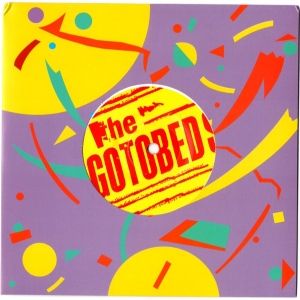
My other Gotobeds singles were compiled on the heartily recommended Fucking in the Future +5, issued by Comedy Minus One in 2017, but fortunately, this joyous, energetic cover of Redd Kross’s first EP is a great way to start off my day. Fun fact: my kids love The Gotobeds. They especially love the song “New York’s Alright (If You Like Sex and Phones),” and almost every time I cover up the ribald parts of the opening lines—“New York’s alright if you can get your dick sucked / Collegiate display of post-classic head-fuck”—with a well timed cough because I’m not ready to have that talk with them yet. Fortunately, there's no harm in them using a Gotobeds can koozie to hold seltzer cans.
Protomartyr and R. Ring / A Half of Seven, Hardly Art, 2015
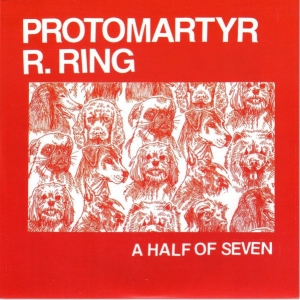
Two Fridays ago I was planning on driving out to Kalamazoo to see Protomartyr perform with Kelley Deal in their lineup, and I was particularly excited to hear them perform the Deal-bolstered “Blues Festival” from this single. It features the tremendously relatable lyric “My brains they run on bad thoughts” and is a highlight of my current running mix, not that I can use the treadmill at the gym for the immediate future. Alas, the show was canceled the morning of, and like countless other shows, I can only hope the country recovers at some point so it can be safely rescheduled. In the meantime, Protomartyr’s new single “Processed by the Boys” has an all-time great video and their next album Ultimate Success Today is due in May. I would be remiss if I didn’t mention how good R. Ring’s “Loud Underneath” is on the flip of this single; I picked up the band’s Ignite the Rest album in Chicago last year and was glad to hear it again.
Warpaint / “NWO (Redux)” b/w “I’ll Start Believing,” Rough Trade, 2016
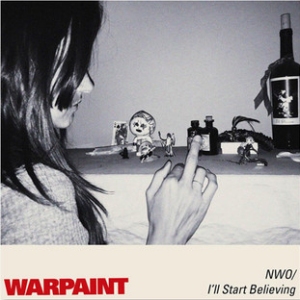
I’ve kept an eye on Warpaint since they released their first EP, but I’ve grown considerably fonder of their melodically charged post-punk over their last few records, particularly 2016’s Heads Up. Early on they had a “sum is less than the whole of its parts” problem, with songs like “Elephant” often getting tripped up by awkward transitions or shoehorned hooks. I credit the addition of drummer Stella Mozgawa with ironing out their songwriting process; their songs excel when built up from the foundation of Mozgawa and bassist Jenny Lee Lindberg (who often carries the melodic load, Peter Hook–style). I don’t know if these two songs, which I enjoy as much as anything else in the band’s catalog, would fit smoothly on Heads Up, but they certainly deserved a better fate than an import-only single.
Arab Strap / “Hey! Fever” b/w “Girls of Summer,” Chemikal Underground, 1997

Arab Strap is stirring again, having recently performed as a duo for a Philophobia retrospective (the album was reissued on vinyl by Chemikal Underground in December), and I would love for another full-blown reunion, given how superb their live sets from 2017 sounded. In the meantime, their discography is exceptionally deep, as proven by this pre-Philophobia single. “Hey! Fever” is a Balearic-tinged pop song with guest appearances from Stuart Murdoch and Chris Geddes of Belle and Sebastian and a lyrical callback to their Arab Strap’s signature song, “The First Big Weekend.” It’s nice, although thoroughly out of sync with a frigid March morning stuck indoors. This studio version of “Girls of Summer” is a faint shadow of the live take from Mad for Sadness (which would easily make my top ten Arab Strap songs), but it’s interesting to hear the starting point for that post-rock rave-up.
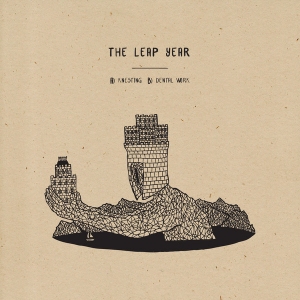
I recently picked up Ten Years (Thank You), Hobbedehoy Records’ 2LP anniversary compilation. I bought it for the exclusive song from The Leap Year, the unusually delicate, acoustic “No Badlands Now,” but the collection holds together quite well, a testament to the varied tastes of the Australian label: post-rock, drone, electronic, shoegaze, and even a touch of emo. The Leap Year only has two full-lengths, this single, and that compilation track, but every song is excellent. “Knesting” lurches between slowcore meditation and bristling catharsis in a way that recalls some post-Slint ’90s indie groups (or perhaps a more bipolar rendition of Jawbox’s “Whitney Walks”), and “Dental Work” is sinewy Midwestern rock from the opposite side of the globe.

Windy & Carl have a new full-length, Allegiance and Conviction, set for release at the end of this week, and I’m disappointed that I won’t be able to drive out to Stormy Records and buy it from them directly. I bought this particular Windy & Carl single at Stormy during a visit to Michigan a few years ago, and talking at length with Windy was a highlight of the trip. Each time I’ve been there since moving, I’ve had a nice conversation with Windy and/or Carl, and I’ve also accumulated more of the group’s consistently compelling catalog (along with some other excellent records like Kali Malone's The Sacrificial Code). This single ranks near the top, offering two somnambulant dream-pop songs and a hand-painted cover with a vibrant, welcoming palette. I’ll hold off on Allegiance and Conviction until I can pick it up in person, whenever that may be.
Kathryn Joseph / “Weight” b/w “Cold,” Rock Action, 2019
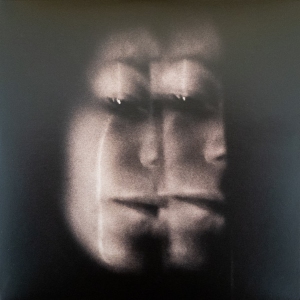
My most disappointing show cancellation of 2019 was The Twilight Sad with Kathryn Joseph, a tantalizing import bill that axed its Boston date after James Graham lost his voice. I’ve seen The Twilight Sad a half-dozen times and I’m sure I’ll see them again, but I haven’t seen the bewitching Kathryn Joseph, whose 2018 album From When I Wake the Want Is possesses a gravitational force. She tours far more sparingly than The Twilight Sad, and whether she’ll make it back to North America at all is a legitimate concern. In addition to her own records, Out Lines, her collaboration with Graham and Marcus MacKay, released Conflats in 2017, and I’m especially partial to its closing track, “These Three Desire Lines.” Their voices work very well together and the arrangements allow plenty of space for the duet to breathe.
Urusei Yatsura / Yon Kyuku Iri EP, Beggars Banquet, 1999

I dove hard into the back catalog of Scottish noise-pop merchants Urusei Yatsura a few years ago after finding a copy of their swan song, 2000’s Everybody Loves Urusei Yatsura. Their mix of Pavement’s smarts, Sonic Youth’s tunings, and Dinosaur Jr.’s fuzz is right up my alley, and while “Slain by Elf” has been a personal favorite since picking up the single at Rhino Records in high school, I was surprised to learn about so many import-only singles that are just as good as anything that made their records. This EP is the shiniest jewel glistening at the back of their deep-cut cave, offering four superlative tracks. “Kaytronika” and the aptly titled “Still Exploding” are noise-pop gems fronted by Graham Kemp, “Nobody Knows We’re Stars” is Kemp’s self-effacing yet still-kinda-affecting acoustic ballad, and “Mother of the MBK” is a sprawling, dynamic contribution from Fergus Lawrie. I looked in countless American stores for this single before finally biting the bullet and importing it (along with a few other Urusei Yatsura singles) from the UK. I still need to find the single for "Eastern Youth" so I can have the b-side The Hearts You Break, though.
Foals / “Red Socks Pugie” b/w “Gold Gold Gold,” Transgressive, 2008
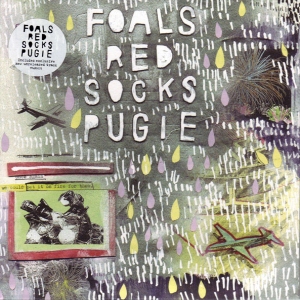
I’m not begrudging their success, but Foals being a very popular band, especially in Europe, is somewhat mystifying to me. The math-rock–infused, melodic post-punk of Antidotes and Total Life Forever (albums I still very much enjoy) possesses greater crossover appeal than, say, Battles, but I hadn’t predicted that they’d be a big Glastonbury act. And yet, that’s what they’ve become, largely trading the latticework guitar parts of “Balllons” and the slow burn of “Spanish Sahara” for chunky riffs and (cough) obvious lyrics on next last few records. Last year they issued the two-part Everything Not Saved Will Be Lost, and my interest was reignited by much of part one (and a comparatively small portion of part two). For a single, “Exits” is an endearingly odd duck (the video still has almost five million views on YouTube), six minutes of off-kilter Tears for Fears homage, but that’s the sort of decision I appreciate seeing. (The meathead rock of Part Two’s “Black Bull,” not as much.) A few tracks even echoed the emotional resonance of “Red Socks Pugie,” which broke through the occasionally clinical Antidotes with some post-emo yearning amid its surging tempos.
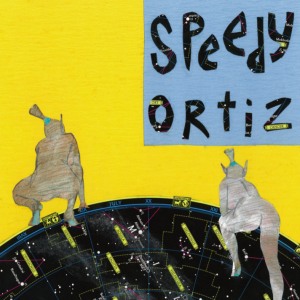
The world deserves a Speedy Ortiz singles/rarities compilation. I don’t know how hard it is to find this particular single, which supercharges two songs from Sadie Dupuis’s earliest Speedy Ortiz recordings with full-band renditions, but there’s plenty more beyond it. Early digital single “Taylor Swift” b/w “Swim Fan” still graces their set lists (and also marks the point where the band sounded like a band), Adult Swim single “Bigger Party” has one of the best lyrical uses of “shithead” in recorded history, the tracks from Foil Deer’s supplemental EP Foiled Again deserve a physical release (particularly “Death Note,” which has a nasty riff), not everyone got the special edition of Twerp Verse with the bonus single, and several other worthy tracks are floating around (like their Liz Phair cover). Hell, put "Cutco" on there because it would be really nice to have "Cutco" on there. Boom, press a thousand copies. A new Sad13 album is due soon, which means Speedy Ortiz will be quiet on new material for a while, the perfect time to prep a singles compilation.
Shiner / “Semper Fi” b/w “A Sailor’s Fate,” DeSoto, 1999
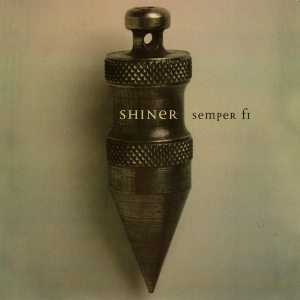
Shiner’s reunion album, Schadenfreude, is due at the end of May, and you can hear “Life as a Mannequin” now. I’m trying not to overdo it on the advanced single, because I know I will listen to the album as a whole a great deal, but the general vibe is Starless with the knowledge gained from five albums with The Life and Times (who remain an ongoing project that you should absolutely keep up with), and I'm pretty happy with that combination. I’m just as excited about the chance to see Shiner again, provided that circumstances improve enough by the end of May (stares blankly into space). I am, however, faced with one of the oddest concert conflicts in my lifetime. The closest currently schedule Shiner date is in Grand Rapids on May 24th, which happens to be the same night as Hindsight 2020 at Matt Talbott’s bar Loose Cobra in Tolono, IL, where Castor, Menthol, and Honcho Overload will be performing. If you’d told me twenty years ago that I’d have to choose between seeing Shiner or seeing Castor, I would be exceptionally confused about the future state of the world.
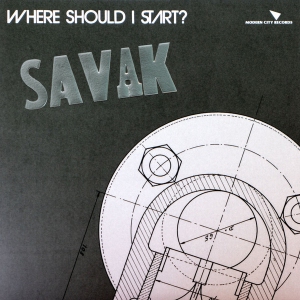
There’s no slowing down Savak, who will soon release their fourth LP (the delightfully titled Rotting Teeth in the Horse's Mouth) since forming in 2015, bolstered by a four-song EP and two singles. “Where Should I Start?” is a propulsive, Krautrock-infused rocker fronted by Sohrab Habibion (formerly of Edsel and Obits, bands with similarly relentless work ethics and consistently rewarding catalogs), while Michael Jaworski sings the brighter “Expensive Things,” which thrives with compositional detail. Savak recently shared a playlist of music from around the globe that was inspiring them lately, and I think that appetite for new and different sounds helps keep the balance of their own songwriting in the sweet spot between fresh and familiar. While this single ranks among my favorite of their releases, the closing tracks from 2017’s Cut-Ups (“I Left America”) and 2018’s Beg Your Pardon (“They Are Not Like Us”) are poignant, politically charged highlights of their ever-expanding repertoire.
Julianna Barwick / “Pacing” b/w “Call,” Suicide Squeeze, 2013

This Julianna Barwick single is among the best seven-inches released in the last decade and a requisite selection every time I play a large stack of singles. (I previously wrote about it here.) As much as I cherish her full-lengths, especially 2011’s The Magic Place and 2013’s Nepenthe, there’s no better introduction to her serenely calming arrangements of vocal loops and gentle piano lines than the a-side “Pacing,” nor a better instrumental respite to be found than the b-side “Call.” Many of her tracks do more in terms of compositional techniques, melodic inspiration, and instrumental variety, but as a distillation of what makes her so crucial to my listening in the last decade, I direct you to this single. She’s been relatively quiet since 2016’s Will, issuing a four-song collaborative EP with Rafael Anton Irisarri (Thesis 10) in 2017 and the five-song cassette Circumstance Synthesis last year, so here’s hoping that another full-length is in the works.
Sunny Day Real Estate / “How It Feels to Be Something On” b/w “Bucket of Chicken,” Sub Pop, 1998

In theory, I don’t need this pre-album single from Sunny Day Real Estate’s original glorious return in 1998, given that the a-side is the title track to How It Feels to Be Something On, and the ingloriously named b-side (written for the soundtrack to The Crow, from which it was rejected, unlike “8,” which made the cut for the Batman Forever soundtrack) has since been included on the vinyl reissue of LP2. But I’m a sucker for this kind of hand-made sleeve, its textured paper reminiscent of countless other care-in-packaging classics from that era (June of 44’s first three releases, the Rachel’s records, Postmarked Stamps singles, etc.). They were bigger than those bands, but still felt connected to the need for a personal touch. If you haven't heard the William Goldsmith interview on The Trap Set podcast, I highly recommend it, although it is very intense and will likely pull the rug out from underneath your prior conception of SDRE's internal dynamics.
L’Altra / Ouletta, Aesthetics, 2002
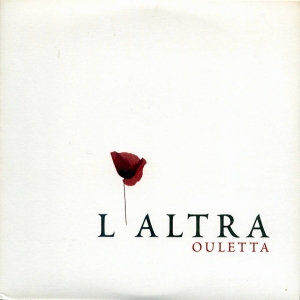
From what I can tell, L’Altra (French for “the other”) has been largely forgotten since their modest heyday in the early ’00s, having last released a comeback-of-sorts album with 2010’s Telepathic. Over their original run of a self-titled 1999 EP, 2000’s Music of a Sinking Occasion, 2002’s In the Afternoon, and 2005’s Different Days, Lindsay Anderson and Joseph Costa’s voices intertwined over an evolving backdrop of Low-esque slowcore, infusing their sound with post-rock, chamber pop, folk, and electronic elements as the additional members of their lineup shifted. (Different Days featured both members of Telefon Tel Aviv after Anderson appeared on three tracks from the group’s 2004 Map of What Is Effortless). Both Anderson and Costa released solo records in 2007, If and Costa Music’s Lighter Subjects, and while I enjoyed those releases, it’s clear in hindsight that they work best in tandem. Ouletta’s quiet strength encourages me to revisit those records in the near future. It's one song split into two parts.
Ocampo, Ocampo, and Watt / “Apparatus” b/w “Better Than a Dirtnap,” ORG Music, 2019
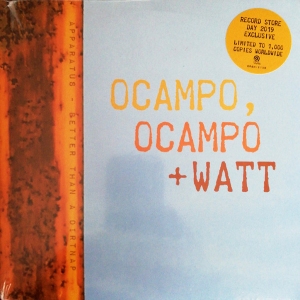
Few tears will be shed over the postponement of Record Store Day this year, as for most people who do not work for the reissues department of a major label, the “holiday” has become a punch-line for the music industry’s worst excesses. But every now and then there’s a legitimate gem released on Record Store Day (or, deep sigh, Record Store Day Black Friday), and last year’s one-off collaboration between Devin Ocampo (of Smart Went Crazy, Faraquet, Medications, Beauty Pill, and The Effects), Renata Ocampo, and the esteemed Mike Watt is one such exception. Anyone familiar with Devin Ocampo’s songs knows that man does not fuck around, and “Apparatus” aligns with his history of excellence, despite the parts being recorded on opposite sides of the country. Watt’s “Better Than a Dirtnap” is a typically idiosyncratic sing-along, a strange song that nevertheless sounds like something you’d known for years. Worth tracking down for fans of any involved parties.
Mogwai / “Mexican Grand Prix” b/w “Slight Domestic,” Rock Action, 2011
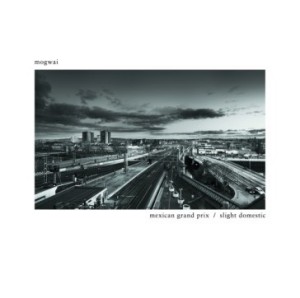
Mogwai hasn’t been quite as productive in the last few years, with their last release being the soundtrack to the sci-fi action film Kin in 2018. (The soundtrack is mostly fine, if less than essential, and I will someday make it through more than fifteen minutes of the film, just not today.) It’s not like the band hasn’t provided me with a surplus of material to enjoy—their vinyl, box sets and all, occupy an entire Kallax cube—but I’ve been spoiled by how regularly they issue both top-line and supplemental material. Their 2011 LP Hardcore Will Never Die, But You Will (which I wrote about at length here) may possess an unquestionably superb album title, but the song selection is somewhat baffling, as the measured, meditative “Slight Domestic” from the b-side of this single and the bruising “Hasenheide” from the “Rano Pano” single each improve upon several tracks from the album.
Pile / “Special Snowflakes” b/w “Mama’s Lipstick,” Exploding in Sound, 2014

Both songs from this single were included on Pile’s accurately titled Odds and Ends compilation in 2018, which collected a bunch of essential tracks from singles and compilations (other highlights include the “Cut off my dick!” screams in “Big Web,” the roaring forward momentum of “Pigeon Song,” and the open fragility of “Keep the Last Light On”). That does not preclude me from pulling out the original single, however, as both of these songs remain among my favorites from the group, and it’s nice to be reminded of just how great of a scope, in terms of both compositional breadth and emotional depth, Pile could fit onto one seven-inch. “Special Snowflakes” was the showstopper, a moody, dynamic rocker that evoked the almighty Rodan in how deftly it handled the switch from a languid stumble to wide-eyed electricity. But “Mama’s Lipstick” was the revelation here, grasping for ineffable memories from youth as present situations ever-threaten to disintegrate.
Constantines / “Our Age” b/w “Fuckin’ Up,” Arts & Crafts, 2008
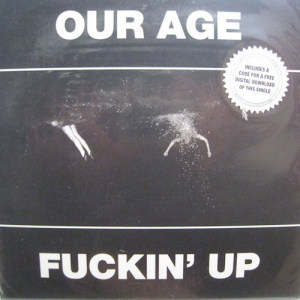
The Guelph-based Constantines are one of those bands that feel very much like they should have been bigger, given how immediate most of their catalog sounds in its Fugazi-meets-Springsteen aesthetic. Perhaps they simply came out too soon, given how other bands mining that general territory found more lasting success in the years following the last Constantines album, 2008’s Kensington Heights. While 2003’s Shine a Light stands as their best album, the bridge between the raw energy of their self-titled debut and the comparatively refined songs from Tournament of Hearts, there’s no single song of theirs I revisit more frequently than “Our Age,” the highlight of Kensington Heights. It’s a classic rock song in the way that many trio-era Silkworm songs are classic rock songs, imparting the accumulated wisdom from their younger, dumber years without sounding like they’re talking down to the kids. There’s a wonderful acoustic rendition on the companion EP Too Slow for Love that’s also worth hearing.
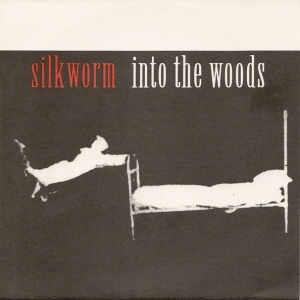
Silkworm / “Into the Woods” b/w “Incanduce California,” Rockamundo, 1993
I wrote extensively about Comedy Minus One’s exceedingly welcome reissue of Silkworm’s In the West last year, and hearing “Into the Woods” from that album on a dusty seven-inch is a good reminder of how tremendous of a job Steve Albini, Tim Midyett, and Andy Cohen did with the remix/remaster of the source material. (There was even a skip before the second verse, to add injury to insult.) I heartily recommend picking up that vinyl reissue (“Incanduce California” is one of the digital bonus tracks) and listening to the episode of Kreative Kontrol with the aforementioned trio of personnel for an enlightening look back at the genesis of the album. Tim Midyett's current band, Mint Mile, just released a double album called Ambertron on Comedy Minus One, but hopefully you preordered that record months ago, had it arrive last week and are enjoying it now.
Tarentel / Two Sides of Myself, Static Caravan, 2000

The post-rock group Tarentel evolved rapidly throughout the course of their existence, going through phases of ambient drones, rhythmic clatter, and psychedelic noise without losing track of a consistent continuum. Having listened to the spacious, haunting drones of 2001’s The Order of Things earlier this week, it’s hard not to see this two-song single as a bridge between the more typical post-rock structures of 1999’s From Bone to Satellite (reissued with bonus material in 2016) and the comparatively skeletal approaches of The Order of Things. It’s worth noting that these songs were recorded in the same time frame (Summer 1999 and February 2000) as my favorite Tarentel material, the “Looking for Things” b/w “Searching for Things” twelve-inch. All four songs, alone with “The Waltz” from their Travels in Constants release, were compiled on Ephemera | Singles 99–2000, which is my ideal soundtrack for reading.
Helium / “Hole in the Ground” b/w “Lucy,” Pop Narcotic, 1993
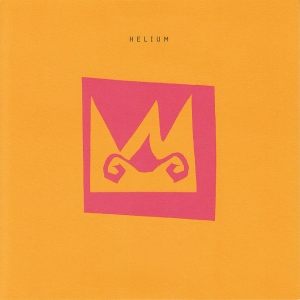
I shouldn’t be surprised that Helium was so good by their second single; after all, Mary Timony had already been in Autoclave and knew how to write arresting songs. But on “Hole in the Ground” and especially the b-side “Lucy” (which I first heard on the disc of bonus material for formative compilation What’s Up Matador), Timony’s noise-pop instincts impress mightily. I could hear an argument that “Lucy” doesn’t need to extend to six-and-a-half minutes, but until No Guitars, Helium tended to stretch their songs out as they saw fit, and “Lucy” deserves to revel in twisting guitar feedback as much as "Baby's Going Underground" needed to zone out in rhythmic bliss. Both sides of this single were included on the 2017 compilation Ends With And, which, like the simultaneous vinyl reissues of The Dirt of Luck and Magic City / No Guitars, are no-doubt pick-ups for anyone interested in rock music .
Telegraph Melts / “Heilgeschichte und Weltgeschichte” b/w “Goodbye No. 20,” Self-released, 1997
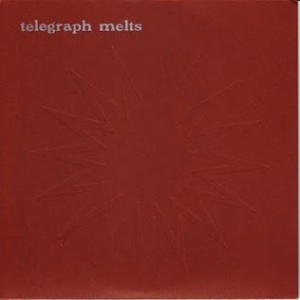
Telegraph Melts was a briefly lived cello-and-guitar duo from two familiar names in the DC music scene. Cellist Amy Dominguez was the driving force for Garland of Hours (along with Brendan Canty), and has done guest spots with countless bands likely in your collection (Fugazi, Faraquet, Mary Timony, Jets to Brazil, Beauty Pill, Ted Leo, etc.). Guitarist Bob Massey was also a member of Tsunami for a spell. Together as Telegraph Melts, they released a full-length, Ilium (which opens with the excellent "Septembrist"), on Absolutely Kosher in 1998 (guest percussion from Devin Ocampo!), and this single. A small, but memorable collection of material that straddled the line between experimental, sometimes abrasive compositions (the slashing guitar noise of “Heilgeschichte…”) and beautiful, affecting post-classical arrangements (“Goodbye No. 20”) reminiscent of Rachel’s. I likely wouldn’t have heard of Telegraph Melts without the early MP3-promoting site Epitonic, but I’m glad that I did.
Ganger / “Geocities” b/w “Alessandra and Her Western Fan,” Wurlitzer Jukebox, 1998
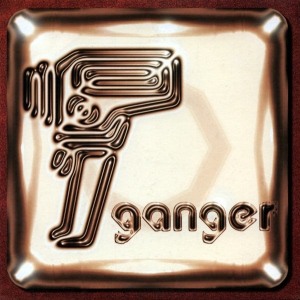
The most obvious reference for Ganger is Mogwai, given that both were prominent post-rock bands from Scotland in the mid-’90s (and I saw them on the same mind-blowing, ear-splitting bill at the Metro in Chicago in September 1999), but on this particular single, a more specific aesthetic touchstone would be the Chicago-based band Dianogah, who explored similar two-bass instrumentals. Technically, Ganger’s lineup included guitarist Craig B. as well, but the basses run the show here, and you could slot either of these songs onto a Dianogah record without raising many eyebrows. A few disparate points: first, the title “Geocities” has largely returned to a positive mental image separate from “gross early web site design”; second, “Alessandra…” was originally a song from Craig B. and Natasha Noramly’s band Fukuyama, whose two singles languish at the bottom of my Discogs wantlist; third, I cannot stress how much better Hammock Style is than anything else in Ganger’s generally likable catalog. If you enjoy post-rock and haven’t heard Hammock Style (start with the incredible "Capo [South of Caspian]"), rectify that error.
Dirty Three & Scenic / Split Single, Narwhal, 1998
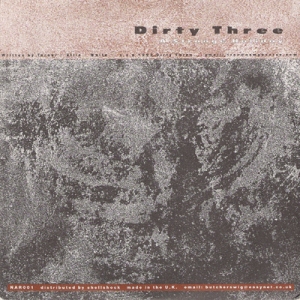
If you’re looking to author some indelible mental pictures while stuck at home, you can do a lot worse for inspiration than the instrumental compositions of Dirty Three and Scenic. I recently listened to Dirty Three’s classic run of albums (1996’s Horse Stories, 1998’s Ocean Songs, and 2000’s Whatever You Love, You Are) and it’s impossible to overstate their greatness. “A Strange Holiday” is on par with those records, a largely piano-dominated lament that gives way to Warren Ellis’s multi-tracked violin in its final minutes. (I recently watched the Nick Cave documentary 20,000 Days on Earth, and Ellis comes across as a supremely endearing human being, especially the scene in which he’s directly a children’s choir.) I know Scenic more for guitarist Bruce Licher’s Independent Project Records / Independent Project Press, which upped the ante on record packaging in the ’80s and ’90s, but I own several of Scenic’s impeccably packaged albums on CD somewhere, and their songs are evocative of many things, but most specifically open Western landscapes. “When the Time Comes” is more brisk than ponderous, but it’s a nice complement to Dirty Three’s track.
Beastie Boys / “Sure Shot” b/w “Mullet Head” Capitol, 1994
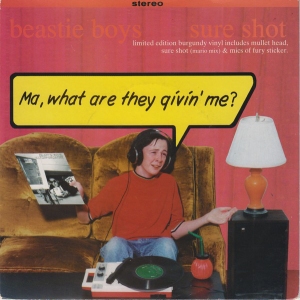
The Beastie Boys were one of the groups in the ’90s that I generally enjoyed but were inescapable enough that I didn’t feel any need to actively put them on—I’ve undoubtedly seen the video for “Sure Shot” dozens of times—but after Adam Yauch passed away in 2012, I made a more conscious effort to work through their catalog. I appreciate their work in the following order: Paul’s Boutique, the singles from their ’90s albums, their general cultural presence, the entirety of their ’90s albums, and then maybe Licensed to Ill and their later records. Last year I read Book, which is a supremely entertaining read for even fair-weather fans like myself, and worth checking out of your local library the next time it's open. I am glad that I picked up this single at Mystery Train at some point; “Sure Shot” is a classic and I enjoy doing the dog-saying-“I love you” intro, “Mullet Head” is a better-than-you’d expect rocker with a neat snaking guitar part midway through, and the remix, while unnecessary, isn’t unlistenable.
Bloc Party / “Two More Years” b/w “Hero,” Wichita, 2005
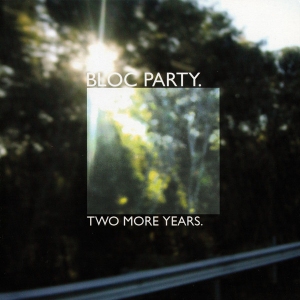
I pulled out Bloc Party’s Silent Alarm earlier this week, and as I do every time I listen to that album, I started thinking about how quickly and thoroughly they squandered its excitement. 2007’s A Weekend in the City isn’t a complete whiff (I like “Hunting for Witches”), but it’s a step in the wrong direction, one which placed too much sonic detritus in the way of the clear, well rehearsed instrumental interplay that drew me into Silent Alarm. (And that was before they started 2008’s Intimacy with a drum break overwhelmingly reminiscent of Chemikal Brothers’ “Block Rockin’ Beats.”) The biggest problem with Bloc Party’s second record is that they could have made it sooner. They had a number of excellent non-album tracks that were left to import singles, as exhibited here by the catchy “Two More Years,” and if they’d simply collected those for Silent Alarm’s follow-up instead of frittering them away, things might’ve gone better in the long run. ("Hero" is a b-side, through and through.) It was particularly noticeable when “Little Thoughts,” another non-album single, popped up in the middle of my American pressing of Silent Alarm, and I immediately thought “This song wasn’t on the album” followed by “Why wasn’t this song on the album?”

Merge wisely pressed these two Adult Swim Singles Series tracks to vinyl in 2017, just like they’d done for Wye Oak’s outrageously good covers of The Kinks’ “Strangers” and Danzig’s “Mother” from the AV Club’s Undercover series in 2011. “Spiral” originally came out in 2012, when I thought its danceable rhythms and rolling marimba melody were interesting stylistic divergences instead of signs of things to come. I was wrong! “Wave Is Not the Water” came out in 2017 and is much more in line with the following year’s excellent The Louder I Call, The Faster It Runs. Wye Oak has issued a number of digital singles leading up to their five-piece-band tour Join (which was sadly interrupted), and I wouldn’t be surprised if an album including those songs arrives this fall, hopefully with a tour stop in Michigan. It would be wild to see them perform with Andy Stack out front playing bass.
The Fall / Bingo-Master’s Break Out!, Superior Viaduct, 1978/2016
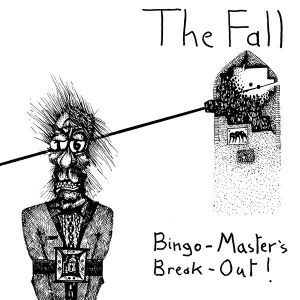
I was slowly working my way up to it, but after Mark E. Smith passed away in 2018, I committed myself to a thorough appreciation of The Fall. I listened to virtually everything the band released—albums, Peel Sessions, singles, rarities—up until around 2000, at which point I very understandably needed to put the project on hold. If there’s a core truth about The Fall that I can impart, it’s that all of those things are important to understanding the band. I could say “1980 through 1986, that’s the best era, Perverted by Language is my favorite album, a singles collection like Palace of Swords Reversed is the best starting point,” but dabbling doesn’t paint the whole picture. I needed to understand that Smith used the albums for different purposes than the singles, that sometimes the definitive version of a song would appear on a Peel Session before or after the release of the album, because you needed to hear all of the versions (exhibit one is “New Puritan”), that knowing the names on the sleeve was critical, even if only one name truly mattered. (That name? Steve Hanley. Kidding, maybe.) It’s even evidenced here on their first single (the only seven-inch I own from them). The two antsy post-punk songs on the a-side are the appetizer, and the rambling, ranting “Repetition” on the flip is the main course.
Hot Snakes / “I Shall Be Free” b/w “A Place in the Sun,” P U, 2020
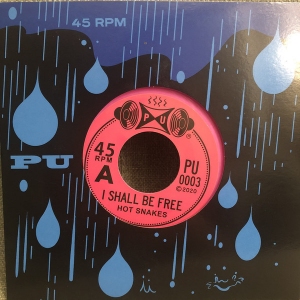
It pays to have friends who will buy an extra copy of a limited-run, available-at-shows-only single and mail it to you, so without my friend Scott, I would not be listening to the new Hot Snakes single right now. These songs will appear on their next album, presumably due in the fall, so if you’re upset about missing out, you won’t languish in misery forever. As per Hot Snakes standards, both songs totally rip / smoke / shred / kill / eviscerate. Whatever trending verb you’ve got, this single does it, the Hot Snakes guarantee. “I Shall Be Free” opens with their telltale melodica, but soon breaks out into a pounding, mid-tempo series of body blows. “A Place in the Sun” is even better, an all-out rocker with a riff near the end of the song that recalls some of Drive Like Jehu’s crazier moments. Let me preorder the next record now and Rick Froberg can blow my twenty bucks on art supplies to keep himself busy.
Fucked Up / “Blink” b/w “The Way We Did,” Fucked Up Records, 2014

I’ve played a lot of records this week, but given that my wife is working from home and my kids are attempting to keep up with school, the vast majority of albums qualify as unobtrusive. I’m glad to rotate through my stacks of ambient, drone, modern classical, post-rock, and Kosmiche records, but one day after dinner I put on Fucked Up’s The Chemistry of Common Life, and it felt alive in a way that much of this last week hasn’t. It also reminded me of the times that I’ve seen Fucked Up, and how sweaty those shows are in the best possible way. The Fucked Up live experience may only exist in fantasy right now, but fortunately they have released a metric fuckload of records, and I own a good, if by no means complete, collection of them. A personal favorite is this tour single, purchased at a concert in San Francisco. Both songs rank among my favorites for the band, and I’ve found myself putting it on quite a lot over the years for a small dose of a band that’s often served in overwhelming portions. Apparently it's hard to come by because a box of them fell out of their van on the way to Los Angeles, the classic punk rock mix-up.
The Twilight Sad / “The Room” b/w “The Neighbours Can’t Breathe (Acoustic),” FatCat, 2010
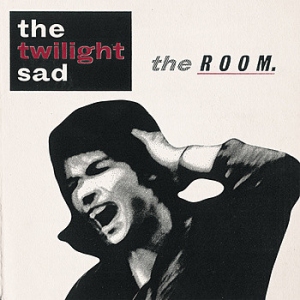
The Twilight Sad has issued a tall stack of seven-inches that would make worthy choices for today, most recently the “Rats” b/w “Public Housing” supplement to their 2019 album It Won/t Be Like This All the Time (fingers crossed). But it’s hard to pass up a single with one of their best songs on the a-side and an acoustic version of another one of their best songs on the b-side, both from their underrated 2009 album Forget the Night Ahead. (I could make a convincing argument that each of their albums since their rightly heralded 2007 debut, Fourteen Autumns and Fifteen Winters, is underrated in some capacity.) “The Room” appropriates the insistent, minimal pound of Nine Inch Nails’ “Hurt” for a comparatively warm, if typically inscrutable tale. I’m also partial to the live rendition with the Royal Scottish National Orchestra. Regardless of the arrangement, it’s all about James Graham’s voice. “The Neighbours Can’t Breathe” strips the jet-engine roar from the album version to reveal Andy MacFarlane’s delicate arpeggios and loses none of its mystery.
Cloakroom / “Lossed Over” b/w “Dream Warden,” Run for Cover, 2014
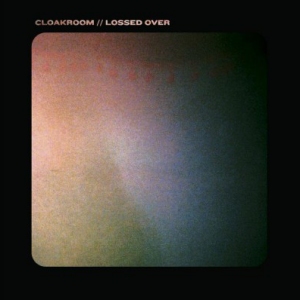
Cloakroom was scheduled to open for Caspian in Detroit this spring, but like many others, that show was postponed indefinitely. They’ve toured in the last year, but haven’t released anything since 2017’s Time Well, which was my introduction to their blend of Hum’s guitar tones, Pinebender’s crawling tempos, and Songs: Ohia’s wounded emotions. The a-side of this single appears on their 2015 album Further Out (its closing track, “Deep Sea Station,” is one of those songs I’ll play a half-dozen times in a row), but its b-side is exclusive to the single, and features Hum’s Matt Talbott, who produced Further Out, on vocals. I know Hum is still threatening to release a new record one of these years (“It’s almost ready” I’ve heard, quite a lot), but “Dream Warden” is a few ripping Tim Lash leads shy of being a fantastic Hum song.
St. Vincent / “Krokodil” b/w “Grot,” 4AD, 2012
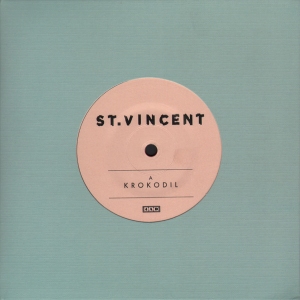
Another rare instance of an essential record being released on Record Store Day, this St. Vincent single might be my favorite thing that she’s released. St. Vincent played a set of Big Black covers in 2011, and it’s hard not to hear “Krokodil” as embodying that abrasive spirit. That isn’t to say that it’s pale mimicry or uninspired tribute—“Krokodil” certainly has the manicured arrangements of Strange Mercy in its DNA as well—but it’s an exceptionally interesting direction for her to take given how fast her star was growing at that point. “Grot” is even better, as Annie Clark caustically delivers power-structure critiques over a slow-motion collision of enchanting vocal loops and super-heavy, warped riffs. On one level it’s disappointing that she didn’t pursue this direction further or longer, on another level perhaps it’s the exact right amount to pursue this direction.
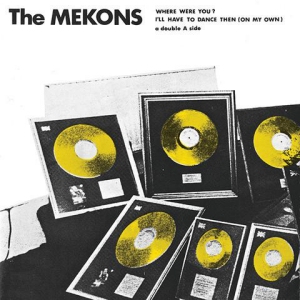
As someone who counts 1985’s Fear and Whiskey among his favorite albums, it’s slightly embarrassing that it took me this long to properly explore The Mekons’ earliest recordings when they were in the same post-punk class as Gang of Four (literally: both bands formed at the University of Leeds). Some of this delay came down to availability, since they’re a band I mostly listen to on vinyl, and while I had been able to find copies of their key records from the ’80s and early ’90s with relative ease, I simply didn’t run into 1979’s The Quality of Mercy Is Not Strnen, 1980’s self-titled album, or their early singles in American record stores. Some of this delay came down to reputation, as their early days are often discussed as being an art school lark that never took itself very seriously, especially in contrast to Gang of Four. Fortunately, Superior Viaduct has reissued their first two singles and their debut record, and my immediate takeaway from spending adequate time with this era of the band is that it’s far, far better than reported. They possessed a freewheeling, egalitarian artistic spirit, but they wrote post-punk songs that were just as good as their compatriots’. Here, “Where Were You?” evokes a more lighthearted track from Wire’s Chairs Missing and “I’ll Have to Dance Then” nicks some of Gang of Four’s funkiness.
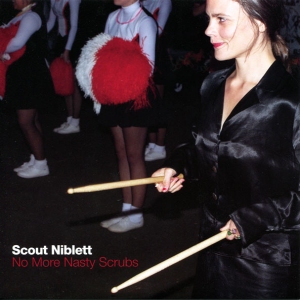
Last year I read Erin Osmon’s Jason Molina: Riding with the Ghost, an enlightening and eventually very harrowing look into the life and death of the Songs: Ohia and Magnolia Electric Co. captain. The book discusses how Molina gave Scout Niblett’s demo to Secretly Canadian, which led to her signing with the label, and how they would share a split single. I had seen her name before, but didn’t know anything about her, so when I checked out Wikipedia, I learned that 1. we are birthday buddies 2. she released a single with covers of Janet Jackson’s “Nasty” and TLC’s “No More Scrubs.” I made a mental note to find that single, and as if fate had deemed me worthy, I found a copy at Dearborn Music a few weeks later. Her rendition of “Nasty” is appropriately sassy and drum-heavy, but it’s her sober, bluesy take on “No More Scrubs” that rewards that initial connection with Jason Molina. Granted, covering an R&B song is far more of a Will Oldham move, but Niblett does both sides of this conceit justice. Now I need to make a mental note to find more of her records.
Wire / “A Question of Degree” b/w “Former Airline,” Harvest, 1979
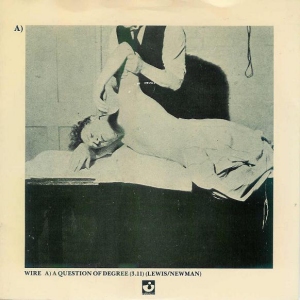
I own two copies of the most essential Wire non-album single, given that I’d bought this original a few years before all of their early singles (most of which I did not previously own) were collected in the Nine Sevens box set. But it’s hard to complain about having another copy of “A Question of Degree,” one of Wire’s best tracks, and the platonic ideal of guitar-driven post-punk. The flip is, in a particular sense, an accurate prediction of the upcoming 154, as “Former Airline” buries what could have been a straightforward post-punk track in layers of abrasive production noise (horns, strange sounds, guitar slashes—who knows). As with 154, it works because of what accompanies it. I can listen to all of 154 because for every unsettling “Indirect Enquiries,” there’s a perfectly crafted “Map Ref. 41°N 93°W” to help it go down.
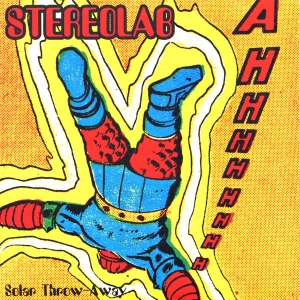
Seeing Stereolab on their fall tour last year was one of my biggest priorities and toughest logistical challenges; I had to make an educated guess as to where I would be living at the time, and thankfully, I correctly surmised that I would be closest to their Detroit date. It was worth all of the stress to finally see them perform. Laetitia Sadier has a completely enchanting stage presence, Tim Gane seemed thoroughly pleased to hyper-strum on the side of the stage, and substitute bassist Xavier Muñoz Guimera handled those exceptionally dexterous bass line and the dearly departed Mary Hansen’s background vocals with jaw-dropping aplomb. They played the songs I wanted to hear the most—“Crest” and “Jenny Ondioline”—but showed that any song from their vast catalog could be captivating. Over the next few months I worked through their series of expanded reissues, seven in total, and at no point did I wish that there was less to go around. Next up, to the best of my knowledge, is Switched On Volume Four, another collection of non-album material, which I presume will include this single. I genuinely couldn’t remember what these songs sounded like before putting it on, but the a-side is a particular treat with its mid-song shift. Will we get new Stereolab music? Who knows, but I’m ready and waiting if they do.
Errors / “Magna Encarta” b/w “Ganymede,” Rock Action, 2010
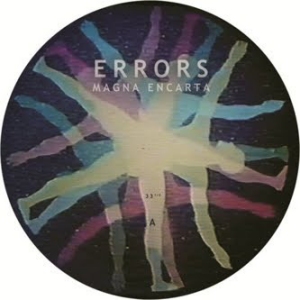
It’s a bummer when you have to come to your own conclusion that a band is done making music—such is (presumably) the case with my beloved Scottish post-electro band Errors. Their last record was 2015’s Lease of Life, for which they did comparatively little touring (no live footage of this material is on YouTube), and it now seems safe to say that the inventive, vocal-heavy synth pop of that album marked their final evolution. I’m glad that I was able to see them at Great Scott in Allston in 2012, and especially appreciative that they performed “Magna Encarta,” my favorite song from the group. It marked the farewell of original guitarist Greg Paterson, who left the group before 2012's superlative Have Some Faith in Magicto pursue dentistry, and over its six minutes there’s a still-impressive array of terrain covered, from poignant slide guitar leads, to subterranean video game level neuroses, to wordless yet emotive vocals. It easily ranks among my favorite songs from the last decade. The b-side, “Ganymede,” is comparatively slight, but tonight I appreciated its womb-like enclosure.
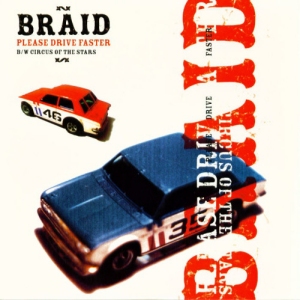
It’s somehow been only five weeks since most of my Twitter feed was griping about Vulture’s Top 100 Emo Songs instead of worrying about their potential doom, but time flies when you’re vastly overrating American Football. I kid—mostly. As much as I like American Football (albums one and three), it remains a brain-breaking thought that a band who was mostly an afterthought in Champaign, where I moved to for college in 1999, would be the most heralded, influential act in emo twenty years later. If you’re familiar with Upright Citizens Brigade bits, it’s like asking the robot, “How come?” I just can’t wrap my head around it. If I were a betting man and had to pick one Champaign band to take that crown, I would have said “Oh, it’ll be Braid” in a split-second. Their last show was on my first night in college and it was packed. People cared about their string of posthumous releases. Other bands aped their sound. Post-Braid act Hey Mercedes was on every bill in Illinois for a solid year. Am I saying that Braid deserves to be the most heralded, most influential emo band? No, not really. I’m happy to pick and choose from most of their catalog prior to Frame and Canvas and this single, which was later included on Movie Music Vol.1. Their legacy isn’t half-bad: they enjoyed several reunions and put out a solid full-length with 2014’s No Coast. But if you presented two anonymized paths and asked me which one would be American Football’s and which one would be Braid’s, I would have been dead wrong. Don’t trust me on anything.
Lower Dens / “I Get Nervous” b/w “Johnssong,” Gnomonsong, 2010

Jana Hunter had been making music for years before forming Lower Dens, but it remains impressive that the group formed in 2010 and released Twin Hand Movement the same year, given that it’s such an assured, thought-out debut. The element that stands out to me about both “I Get Nervous” and the non-album b-side is how ’50s pop is foundational in the sound—the reverb-heavy guitar, the slow-dance tempos—and yet neither song sounds like an explicit throwback. After enjoying Twin Hand Movement, I was floored by “Brains,” the lead single for their sophomore album, 2012’s Nootropics, and how it felt like the future in a way that few songs do. (I put it on a few months ago and it still does sound like the future.) Given the penchant for dramatic stylistic shifts (and the departure of the other original members of the band), I shouldn’t be surprised by Lower Dens’ switch to mining of ’80s synth-rock on their last two records, but I haven’t found as much about those records that engages me as on their first two.
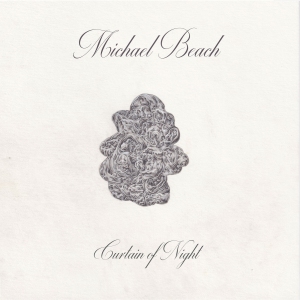
Australian native and periodic Oakland resident Michael Beach released one of the best records of 2017 in Gravity/Repulsion, which recalls both American classic rock staples and New Zealand rock imports over its eight songs and twenty-six minutes. There are short records and there are concise records, and Gravity/Repulsion is the latter, but even within its tidy runtime, there’s a sense of sprawl and space to “A Vision of Modern Love” and “Freddie Dreams of Mars” that most artists would waste hours trying to capture. This single introduces his new backing band, The Artists, with one original song, the affable and immediate “Curtain of Night,” which slides on like a well worn pair of jeans that somehow hasn’t developed an embarrassing hole in the crotch, and one cover, a coiled, tense rendition of Peter Jefferies’ “Electricity.”

I never miss an opportunity to harp on the greatness of Polvo in general and post-reformation Polvo in specific, so when I saw the largely slept-on “Heavy Detour” single in the box, I pulled it out over some classic competitors. This single came out between 2009’s In Prism and 2013’s Siberia (which may be the best Polvo album if you let me talk at you for a half an hour), and the a-side is exclusive to the single, while the b-side was re-recorded for Siberia. “Heavy Detour” is a Dave Brylawski–fronted track, and I suspect fans are slightly cooler on those songs than ones Ash Bowie sings, but it’s a solid track. (Is one of my main arguments in favor of Siberia that Brylawski’s songs are every bit as good as Bowie’s on that album? It sure is!) The synth strings are a key component and there’s a groove to the song, both elements that Polvo generally avoided but work well here. Bowie’s “Anchoress” is an interesting case—there’s this version, an alternate take that was available as a bonus download, and the final version that made Siberia. I enjoy this version for its differences (much more prominent synths, a funny vocal “Yeah huh” from Bowie before the outro), but the Siberia version hits the proper, slightly somber tone.
The Paradise Motel / “Drive” b/w “Drive (Mogwai Mix),” Infectious, 1999

In the early days of filesharing, songs were often mislabeled in hilariously egregious ways, but a subtler mistake accompanied my original encounter with Mogwai’s remix of The Paradise Motel’s cover of The Cars’ “Drive.” It was simply labeled as a Mogwai song, no mention of The Paradise Motel. I don’t think it took long for me to learn that it was a remix (not that I learned anything about The Paradise Motel in the process), but I still enjoyed its exceptionally minimal, digitally processed lullaby rendition of that Cars song. Last year, I came across a cheap copy of this seven-inch, and heard the unaltered cover for the first time. It’s pleasant and similarly minimal for the first half (the vocals lack digital processing), and then a very prominent string arrangement elbows its way into the song. That arrangement mercifully fades, but the calm has been broken. Mogwai’s version focuses on the original synth melody and the digital layers over Merida Sussex’s vocals. It never peaks, it just glides. It’s exponentially better than the source material.
Wipers / Alien Boy, 1980/2019
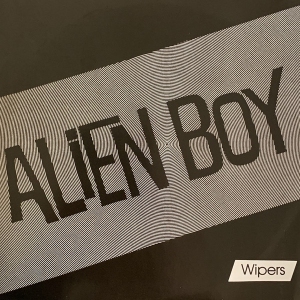
I don’t actually believe that Greg Sage existed in a vacuum, sealed off from the rest of punk and post-punk in Portland, OR, but when I listen to the Wipers’ music, it feels disconnected enough from the trends and techniques popular elsewhere at the time that I can at least entertain the thought. This EP includes “Alien Boy” from their debut Is This Real? along with three outtakes from those sessions. It feels very much like a bridge to their next release, 1982’s Youth of America. It invokes that record’s mood—its paranoid, lonely, nervous energy—but with the three non-album tracks fitting on the b-side, not Youth of America’s sense of scope. “Voices in the Rain” in particular has the sing-speak delivery that’s used a number of times on its follow-up.
|

First things first: You can view (and sample!) my top 25 albums of 2013 and my top 12 albums of 2012.
Yes, it took me a full year to finish a list for 2012. Yes, it only has twelve albums. No, that doesn’t necessarily imply that 2012 was “a terrible year for music,” nor does my doubled selection total mean that 2013 was “a great year for music.” (Any time I see those grand declarations, my eyes roll into the back of my head.) I listened to fewer albums in 2012, many bands I’d usually slot in by default had an off year, and I had less time and enthusiasm in December to complete a list, let alone replicate my exhausting review of the previous year’s contending titles. Comparatively, tons of bands—familiar and unfamiliar—issued worthy albums in 2013, I regained some energy for listening to and occasionally writing about music, and my wheelhouse genres of angular indie rock and ambient had strong years. I’m unwilling and unprepared to objectively declare 2013 a fantastic year in music for all tastes, but for mine, it certainly was. Subjectivity strikes again!
In case two year-end album lists isn’t enough, here are some supplemental selections.
Ten Honorable Mentions from 2013:
- Brokeback, Brokeback and the Black Rock (“Colossus of Roads”)
- Shane Carruth, Upstream Color Soundtrack (All of it)
- CHVRCHES, The Bones of What You Believe (“Tether”)
- Joanna Gruesome, Weird Sister (“Sugarcrush”)
- Overseas, Overseas (“Old Love”)
- Savages, Silence Yourself (“She Will”)
- Superchunk, I Hate Music (“Void”)
- Tomahawk, Oddfellows (“Southpaw”)
- Justin Walter, Lullabies and Nightmares (“The Way of Five”)
- Yo La Tengo, Fade (“Ohm”)
Eight Excellent Seven-Inch Singles from 2013:
- Alpha Cop / Carton, Split Single
- Julianna Barwick, “Pacing” b/w “Call”
- Daria / Office of Future Plans, Split Single
- Fat History Month / My Dad, Split Single
- Future of the Left, Love Songs for Our Husbands
- Loscil, Sine Studies I
- Lower Dens / Horse Lords, Split Single
- Speedy Ortiz, “Hexxy” b/w “Ka-Prow!”
Two Sources of Ongoing Ethical Conflict
- “Free” concerts offered by shoe companies: I enjoy not paying for things as much as the next guy, but tripping over future landfills worth of Vans promotional garbage at The Walkmen’s potentially final show in Boston and seeing “Converse” emblazoned on the chest of The Men’s bassist has forced me to recognize that corporate back-slapping always has a price.
- Band-circumventing vinyl reissues: I enjoy re-buying beloved 1990s albums that I already own on CD way, way more than the next guy, but 1972 Records’ Stereolab reissues are almost certainly sourced from those very CDs instead of the original masters and have no involvement from Tim Gane or Duophonic, while Shop Radio Cast’s wish-fulfilling pressing of Hum’s You’d Prefer an Astronaut cut Matt Talbott’s attempts to reissue the album on his own terms down at the knees. (Fortunately, he has a stockpile of original copies you can occasionally buy.) Labels, be more like Numero Group and add value to your reissues by actually involving the artists who created them. Bands, be proactive in reissuing your catalogs so that shady operations don’t do it first. Record collectors, investigate the origins of the reissue you’re holding before you plunk down $27.99 on it.
Two New Year’s Resolutions for 2014
- Actually finish reviews and features: If I merged my partially and mostly completed posts from the last two years, I’d have a damn book.
- Keep reminding myself about that first resolution: I'll have a headstart on months of posts, at least.
|

Should I even use the word “reunited” in reference to Polvo anymore? Since their 2008 reformation, they’ve reworked their back catalog for live sets, released an excellent LP in 2009’s In Prism, and rather suddenly re-emerged with this single. Unlike a certain reunited band who’s remained in set-list stasis for eight years now, Polvo’s too restless to stand still.
“Heavy Detour” b/w “Anchoress” heralds the group’s as-yet untitled new album, due on Merge Records in an as-yet unannounced timeframe. The a-side, available for streaming here, splits the difference between the mid-tempo pace of Dave Brylawski’s three contributions to In Prism and the driving guitar loops of “Beggar’s Bowl.” Brylawski’s vocal melodies have improved, the energy level is up, and the presence of both sitar and electronic strings (reminiscent of Helium’s The Magic City) makes perfect sense. “Heavy Detour” bodes well for that upcoming LP.
Ash Bowie’s “Anchoress” takes a more ponderous route, exploring one of Bowie’s intractable, vaguely unsettling narratives with lyrics like “The seasons turn and she fashions a shrine / Arranging all the apples in symmetrical lines.” Lighthearted keyboards cut through the atmosphere, but the song’s keyed by its tense closing jam, which threatens to run long before a 45-enforced fade-out.
The alternate take of “Anchoress,” available as a digital download with purchase of the 7”, revisits the mid-fi production values of Polvo’s Today’s Active Lifestyles and Exploded Drawing. The noisy guitars are a welcome return to that era, especially when they recall the lurching of “When Will You Die for the Last Time in My Dreams.” While I’ve grown to appreciate the polish of In Prism and “Heavy Detour,” the grime of this alternate take of “Anchoress” fits the tone of the song better.
To return to my opening point, no, I should not use “reunited” in reference to Polvo’s post-2008 output. “Heavy Detour” b/w “Anchoress” isn’t a worthy pick-up because it’ll scratch your nostalgic itch; it’s a worthy pick-up because these two songs are excellent additions to a daunting discography. That’s past tense vs. present tense, and it’s time for more of Polvo’s reunited peers to join them (and Superchunk, Dinosaur Jr., Mission of Burma, etc.) in the latter category.
|
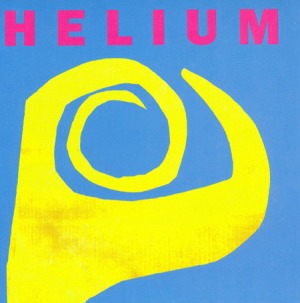
I picked up a used copy of Helium’s 7” for “Pat’s Trick” at Reckless Records and got a booby prize in the sleeve: the sales slip from the previous owner’s original purchase of the single. Along with the Helium find, the haul included two additional singles, each priced at $3.49: one from the space-rock band Flying Saucer Attack (recently recalled by Scott Tennent of Pretty Goes with Pretty) and one from Grenadine (a Simple Machines band featuring Tsunami’s Jenny Toomey and Unrest’s Mark Robinson playing 1920s-style ballads). Sadly, the slip didn’t include any further details, like the store name, the specific singles purchased, the date of sale, or the physical singles for Flying Saucer Attack and Grenadine, so my walk down someone else’s memory lane is cut short.
If you need a refresher on Helium, here goes: Washington, DC expatriate Mary Timony trekked up to Boston for college, leaving behind Dischord’s Autoclave, and replaced Mary Lou Lord in the fledging Helium. I can’t imagine Helium without Timony’s vocals, which alternate between airy wisps and husky monotones, let alone the medieval melodies of her guitar work and the simultaneously inviting/dismissing lyrics. They released two full-lengths, 1995’s fuzzed-out The Dirt of Luck and 1997’s prog-rock-inclined The Magic City, which rank among my favorite Matador Records releases, along with a few essential EPs (Pirate Prude, No Guitars, and the CD5 Superball+, which offers the superb “What Institution Are You From?” [live video link!]). Polvo’s Ash Bowie (Timony’s then-boyfriend) joined the group on bass prior to The Dirt of Luck, and there’s some bleed-through from that group’s off-kilter melodic approach. Helium split up following The Magic City, leaving Timony to an excellent solo career and now Wild Flag, but as you can tell from my purchase of a seventeen-year-old single (cue depression), the original documents hold up.
A-side “Pat’s Trick” is the lead track from The Dirt of Luck, and an excellent intro to the record’s strengths. It made an appearance on Beavis & Butthead, on which the guys commented on double-meanings and the small size of Timony’s nostrils, following up a showing of Helium’s “XXX” video which provided an ample dosage of zingers (“Hey Butthead, I think the TV’s on slow,” “I think this chick just, like, woke up or something,” “She probably doesn’t really start rocking until later,” “Check it out her guitar’s broken”).
The flip side offers the aptly titled “Ghost Car,” a haunting piano ballad muses how “What I’ve got can make you stop this ride to hell so I can get off” and closes with a muted warning to “Stop this car before it goes too far.” It’s an intriguing diversion, but fits better as a b-side than a missing piece of The Dirt of Luck.
From what I can tell, Helium’s b-sides aren’t available digitally, so I can pass along this compilation of b-sides and non-album tracks with more excitement than guilt. Highlights include early single “Lucy” (which appeared on the bonus disc of What’s Up Matador), an alternate take of “Superball” with Joan Wasser from the Dambuilders (who also joined Timony in Mind Science of the Mind, a short-lived side band fronted by Nathan Larson of Shudder to Think), and the aforementioned “What Institution Are You From.” Godspeed to the Soulseek user who initially compiled this material.
|

One of my earliest memories of a home-run band comparison was Parasol Mail Order’s catalog description of Paik’s 1998 debut album Hugo Strange as a cross between Polvo and My Bloody Valentine. Those bands were titans of my late ’90s listening habits—not that I’ve abandoned those predilections—and I watered at the mouth at the promise of a new group combining Polvo’s tunings and My Bloody Valentine’s textures. When I heard Hugo Strange, I immediately understood where the comparison came from, but also grasped that there was more to Paik’s woozy instrumentals than a genetic splicing of those two aesthetics. (This point was hammered home by Paik’s superbly sprawling 2002 LP The Orson Fader and its tidier 2006 counterpart Monster of the Absolute, both highly recommended.) If only all such tantalizing comparisons could bear such fertile fruit.
Perhaps it’s déjà vu, but more than a decade later, Me You Us Them signals the same touchstones. The specters of Polvo and My Bloody Valentine cast spells on their 2010 debut LP Post-Data. You could hear opening track “Any Time,” check the properly formatted citations of Polvo’s queasy riff-bending and My Bloody Valentine’s gossamer shine on the lead guitar, and chalk it up to a perfect hybrid. But that song’s clear vocal melodies, which culminate in an earworm of a falsetto chorus hook, break the equation. Much like Paik, the merger of My Bloody Valentine and Polvo is only a starting point for Me You Us Them.
Post-Data offers plenty of other head-turning points of comparison. “Re-Entry” starts out by pairing jet engine swooshes with “ba-ba-ba” vocal hooks, but its half-shouted chorus recalls Pinback’s more energetic moments. The chorus of “Pretty Nettles” could have slipped onto Self’s Subliminal Plastic Motives. The wistful shoegaze of “Wish You Luck” hits the sweet spot of late ’90s groups like All Natural Lemon & Lime Flavors, while the loping arcs of “Drugs” mine similar terrain as contemporary acts like The Depreciation Guild. “Big Time” and “iQuit” step through the haze for urgent indie rock, complete with tricky guitar breaks. The group’s self-titled song layers guitar and keyboards over a nearly spoken-word delivery reminiscent of DC’s great Candy Machine. “As of Now” hits the cool stride of Sonic Youth. In case it’s not obvious, all of these comparisons are flattering, recalling broad swaths of my record collection.
Post-Data closes with its standout track, “Loving like Lawyers” (which they recently performed as a seven-piece, accompanied by fellow New Yorkers Appomattox). Starting out with pounding drums, then adding tremolo-heavy guitar, longing vocals, and a slippery bass line, “Lawyers” offers no obvious points of comparison, just a surplus of confident songwriting. The song head-fakes a fadeout at 2:48 before launching into a soaring, texture-laden outro. “Loving like Lawyers” acts as both a summary of what preceded it and glimpse into Me You Us Them’s possible future. (I underscore possible, since “Research,” their scream-laced contribution to a 2011 split single with Bloody Knives, is a wonderfully unexpected left-turn from the majority of Post-Data). Returning to the Paik parallel, if Post-Data is Me You Us Them’s Hugo Strange, I cannot wait for their Orson Fader, when those initial touchstones have completely vanished, leaving only own signatures behind.
Me You Us Them’s Post-Data hasn’t strayed far from my listening pile, especially in the car, since I first heard it a few months ago. That’s high praise—I will never underrate an indie rock record with intriguing riffs and compelling hooks, since those are increasingly few and far between. Perhaps that’s why Post-Data recalls so many ’90s groups; that was when I spent plenty of time with each album because my financials (and the lack of file-sharing) dictated it. Now it’s all by choice, and I’d simply prefer to hear Post-Data again. Allow me to take a mulligan and slip Post-Data onto my top albums of 2010 list.
|
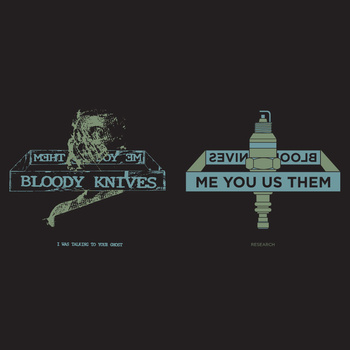
Whether the gateway drug function of split seven-inches has been diminished by file-sharing and streaming media is up for debate, but even if it’s no longer the easiest way to encounter a few new bands, the format can still work. Consider this split between Brooklyn’s Me You Us Them and Austin’s Bloody Knives, which has already prompted me to track down their respective 2010 full-lengths.* Both bands have been lumped in with the shoegaze revival, which fits Bloody Knives better than Me You Us Them, but neither band should be discounted as a stock “Fender Jaguar + Boss PN-2 Tremolo Pan Pedal = Shoegaze!” act. That alone should pique your interest, but an interesting bait and switch on the part of Me You Us Them should maintain it.
Bloody Knives pull off a neat trick with “I Was Talking to Your Ghost”—as the drums, guitar fuzz, and especially bass speed along, Preston Maddox’s vocals float calmly overhead, seemingly disinterested by the racing pulse below. It’s not far off from Oliver Ackermann’s approach in A Place to Bury Strangers, but the lack of gothic overtones to Maddox’s vocals is refreshing. Bloody Knives’ 2010 LP Burn It All Down offers a bit more variety, hitting on the drum-machine dream-pop of early Cocteau Twins, the aggression of APTBS, and the 8-bit textures and bright melodies of the sadly departed Depreciation Guild. Burn It All Down is available for free download from Bandcamp right now. Keep an eye out for their upcoming remix album, Burn It All Up, which should be available from Killredrocket Records in the near future.
No shoegaze touchstones are needed for Me You Us Them's "Research." If you’d told me in January that I’d make a positive comparison to ’90s Amphetamine Reptile outfit Calvin Krime in a 2011 review, I’d assume that either Sean Tillman came out with an atypically aggressive Sean Na Na or Har Mar Superstar single, not that an unfamiliar band was mining similar territory. But the combination of abrasive screaming, driving three-piece rock, and a pressure-relieving melodic chorus recalls the Calvin Krime playbook. It’s hard to tell if the melodic lead is treated guitar or fuzzy synth, but either way, it’s been floating through my head the past few days. I don’t mean to sell MYUT short with the Calvin Krime comparison, especially since that band might not have pulled off this song’s bass-driven bridge or the buried vocals of “Will we ever wake up?” building into screams in the outro as deftly, but I appreciate revisiting the sound.
Here’s the real shocker: “Research” is an outlier in Me You Us Them’s catalog. I missed the boat on their 2010 Post-Data full-length, but it offers a striking mix of Polvo’s woozy riffage, Paik’s early guitar textures (especially Hugo Strange), and the Swirlies’ off-kilter melodies with a touch of punk aggression. In other words, it fits into a fine tradition of using shoegaze impulses in more muscular, less ethereal song structures. “As of Now” is a good starting point.
Considering that I’ve checked out both band’s albums and am particularly keen on spending more time with Me You Us Them’s Post-Data, you can easily chalk this split up as a rousing success. You can stream both songs over at Bandcamp and order the 7” from Triple Down Records or Killredrocket Records.
* The ability to quickly follow up on each of these bands is a welcome departure from the old routine of split singles, when I’d hear a great new band only to learn that their only other released tracks are on an out-of-print local compilation, their albums are only available in Denmark, or they’d split up before recording a full-length.
|
Capsize 7 – Horsefly CD – Pig’s Zen, 2010 (10/15 Reckless Records, Broadway Avenue)

When I think of Chapel Hill indie rock from the ’90s, three big names come to mind: Superchunk, Archers of Loaf, and Polvo. I’ve always appreciated how those bands formed a spectrum: Superchunk at the catchiest, most approachable end, Polvo at the weird, off-kilter end, and Archers of Loaf smack in the middle. It’s a fluid spectrum, since “Harnessed in Slums” and “Web in Front” certainly reign among the finest indie rock singles of the decade, Polvo’s “Can I Ride” and “Tilebreaker” are mix-tape ready, and Superchunk’s dynamic range blossomed with Foolish, but it helps orient where other North Carolina bands—why yes, there were other bands—fit into the scene.
This orientation isn’t always beneficial, as history favors the lasting legacies of big names. Groups like Capsize 7, Geezer Lake, the Raymond Break, Pipe, and Erectus Monotone are mostly footnotes nowadays (quite literally in the case of the Raymond Brake, whose Andy Cabic has gained a higher profile in his indie folk band Vetiver). So imagine my surprise when I find a seemingly new Capsize 7 album in Reckless Records’ CD bins—were they huge in Japan? Did I miss a reunion?
I certainly didn’t mind running into a new Capsize 7 album, even without knowing the back story. I’d first heard their Recline and Go EP when Parasol Mail Order recommended it for fans of Polvo and Archers of Loaf (target market = found) and quickly tracked down their 1995 Mephisto LP, which was issued on Caroline Records. I’ll hand it to Parasol, since I’d place Capsize 7 a touch past Archers of Loaf toward Polvo on the aforementioned spectrum. Tricky guitar work, emotional vocals, and hooks aplenty—essentially what I like about 1990s indie rock in a nutshell. “Western Friese,” “Column Shifter,” and “Pong” made appearances on my mix tapes at the time. Singer Joe Taylor has a touch of Bowie his vocals, which made finding Capsize 7’s cover of “Queen Bitch” (mp3 download) from Crash Course for the Ravers: A Tribute to David Bowie a thoroughly logical loose end.
The back story for Horsefly is all too familiar: following Mephisto, Capsize 7 goes into the studio with Drive Like Jehu’s Mark Trombino, records their sophomore album, gets dropped by Caroline, then breaks up. Their A&R rep at least had the courtesy to give them the rights to their album, which sat around for thirteen years until it was mixed in 2009 and pressed this year. The timing coincides with the release of Taylor’s new band’s first album, Blag’ard’s Mach II.
It’s a shame Horsefly went unheard for so long. It tightens up the hooks and instrumentation of Mephisto without losing its spirit. It’s also filled with lyrical reminders of its history—excellent opening track “Generator” (mp3 download) asks “Did you break up? / Did you try and never make it?”; “Start or Lose” goes into its chorus with a held delivery of “At least I tried”; and the title track features a count-up in years ending in 2009, which was either tremendously prescient or added last year. The modern mix helps to remind me of the good aspects of 1996 indie rock without the drag of dated production values (not that the reliable Trombino is a risk for those issues).
You can get all of the Capsize 7 and Blag’ard recordings direct from Joe Taylor through his Pig Zen Space site, which charges an entirely reasonable $3.50 per album for mp3 downloads and gives most of that money to the artist. (The site design is a 1997 HTML nightmare, though.)
|
|
Sonic Youth is the perfect candidate for the first round of Discographied. As I’ve mentioned before, I enjoy them, but haven’t spent time with a solid chunk of their catalog. At fifteen full-length LPs, that’s no surprise, but given the variance of opinion on their albums past Daydream Nation and Sister, it’s understandable. Fifteen is even a conservative number, excluding the eight EPs of experimental recordings released under the SYR banner, their self-titled debut EP, seven other EPs, soundtracks, singles, bootlegs, solo releases, and the Ciccone Youth side project LP. Needless to say, this endeavor will not be comprehensive. If you want a more comprehensive take on Sonic Youth, consult Mark Prindle.
I’ve chosen to listen to the fifteen LPs and their self-titled debut EP, disregarding any bonus tracks appearing on reissues. Will I miss out on some great songs by ignoring all of those other releases? Sure. Would hearing the noisier, more experimental side of Sonic Youth give me a better sense of their overall aesthetic? Naturally. Would listening to every last song drive me completely insane? Dear God, yes. If you’d like to suggest a few essential peripheral releases, I’m all ears, and will get to them in a bonus round once I’m through with their full-lengths.
This entry will cover their first EP and their first five LPs: Confusion Is Sex, Bad Moon Rising, EVOL, Sister, and Daydream Nation, which is a nice arc covering their 1980s releases and ending before their signing with Geffen.
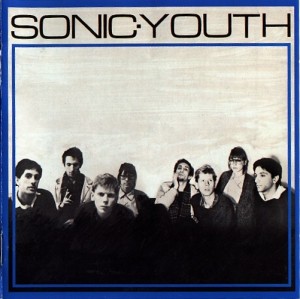
Sonic Youth EP – Neutral, 1982
Highlights: “The Burning Spear,” roughly half of “The Good and the Bad.”
Low Points: The other three songs.
Overall: My prior idea of early Sonic Youth being “unbridled noise that slowly formed into more discernable songs” is completely destroyed by their debut EP. Their lone release featuring original drummer Richard Edson*, Sonic Youth is remarkably mellow. This EP has virtually no guitar noise or feedback and instead emphasizes rototom-heavy drumming, giving it a beatnik vibe in spots. Much like Killing Joke’s debut EP, Sonic Youth feels more in line with the prevailing musical tendencies of the post-punk era than with the signature style featured on their debut full-length. “The Burning Spear,” in spite of a notable Gang of Four influence, is the most memorable track, pushing the guitar chimes to the front and even adding a power-drill wail. “I Dreamed I Dream” features the earliest instance of Kim Gordon’s penchant for artistic sloganeering when she mumbles “Fucking youth / Working youth,” but this blueprint that got significantly better upon reuse. “She Is Not Alone” and “I Don’t Want to Push It” are purely for Edson fans, since the former plods along with only a few guitar chimes and some laconic Thurston Moore vocals keeping me awake and the latter actually features a drum solo. “The Good and the Bad” is an eight-minute long instrumental that begs for more guitar noise and less busy drumming. Gordon keeps it afloat at times, but it’s a losing cause. Cut in half, it would’ve been a solid track, but their guitar textures are simply not interesting enough at this stage to justify such aimless drifting.
Have I mentioned that this EP primarily features standard guitar tunings? Yes, that’s a big sign that Sonic Youth is a false start at the beginning of their catalog. Elements of their signature sound are present, but only “The Burning Spear” brings them to the forefront. Richard Edson simply doesn’t mesh with the group’s style and throws off the tone of these songs. Fortunately, they make some significant progress over their next fifteen LPs, so I won’t judge them too harshly for this one.
*Fun fact: I had no idea that Richard Edson was the parking attendant in Ferris Bueller’s Day Off and Vito in Do the Right Thing.
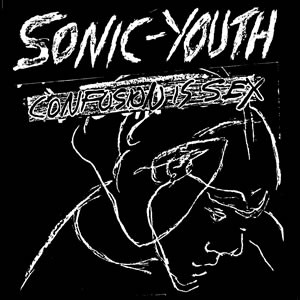
Confusion Is Sex – Neutral, 1983
Highlights: “(She’s in a) Bad Mood,” “Protect Me You,” “The World Looks Red”
Low Points: “Confusion Is Next,” “Making the Nature Scene”
Overall: From its queasy opening chords, Confusion Is Sex opens the proper Sonic Youth era. Gone is the beatnik vibe of the Richard Edson days; enter a newfound emphasis on confrontation and noise as bastions of their approach. Confrontation too often feels forced within music, but it makes an enormous amount of sense within Sonic Youth’s historical and cultural context circa 1983. It’s profoundly different from the more literal take on confrontation favored by hardcore bands like Black Flag and Minor Threat, but no less visceral. This context doesn’t excuse the too-frequent indulges of performance art dramatics, but I’ll take those over the boredom of “She Is Not Alone” in a heartbeat.
The Moore-sung “(She’s in a) Bad Mood” and the Gordon-fronted “Protect Me You” start Confusion Is Sex with an overwhelming sense of doom and gloom. There’s not much structure to be found, but the guitars chime and clang with spooky energy, the bass rumble amplifies the tension, and temporary drummer Jim Sclavunos’s performance is recorded poorly enough to sound menacing. Maintaining this atmosphere proves to be an issue, however. Feedback experiment “Freezer Burn” leads into a live take of the Stooges’ “I Wanna Be Your Dog,” which is a head-shaking drop in fidelity, but at least the latter features Bob Bert’s powerful drumming. “Shaking Hell” starts off with the Gang of Four-esque funkiness from the Sonic Youth EP, but quickly takes a turn down the dark alley where Kim Gordon chants “Shake off your flesh” like a bloodthirsty vagrant. “Inhuman” is defiantly lo-fi rocker with an energy that I hardly anticipated during the first two songs. “The World Looks Red” features lyrics from Swans’ Michael Gira, but it’s Moore’s clear vocal performance and the dueling guitar noises—one sounds like a music box being played backwards at half-speed—that set the song apart. Sadly, the last two proper songs shit the proverbial bed.
“Confusion Is Next” is a clanging, tuneless headache that’s not excused by the punk blast in its final minute. “Making the Nature Scene” is a rambling, Kim-Gordon-yells-things track. At least the instrumental “Lee Is Free” ends Confusion on an interesting note, compiling an array of guitar textures that sound like malformed church bells and frog calls. Its impact is lessened, however, by my utmost certainty that Moore and Ranaldo have thousands of hours of practice tapes with similarly wonky tones.
I’ll commend Confusion Is Sex for being a record of intriguing ideas, but without structure and focus, too many of these ideas veer off course. I was foolish to expect the album to maintain the portentous clamor of its first two songs, but the chaotic flow and weaker tracks diminish the genuinely disorienting feeling of songs like “Protect Me You” and “Shaking Hell.”
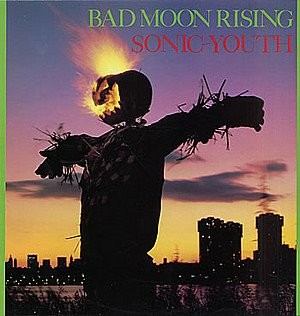
Bad Moon Rising – Homestead, 1985
Highlights: “Brave Men Run (In My Family),” “I Love Her All the Time,” “Death Valley ’69”
Low Points: “Society Is a Hole,” “Ghost Bitch”
Overall: True to its title, Bad Moon Rising feels like a late-night drive down a west Texas highway, as sleeplessness slowly turns into insanity, everyone turns on each other, and morning never arrives. Without the chaotic bits interrupting the sense of portentous doom that began Confusion Is Sex, this mood can actually ebb and flow on Bad Moon Rising, much like the back-half of Wipers’ Youth of America. A consistent rhythmic drone and brief segues between songs tie the album together as a single piece. It’s a marked improvement over Confusion and a proper, timely statement (much like the Wipers’ album), but the individual songs settle into the whole instead of standing apart.
Bad Moon Rising starts on a high note with the mesmerizing arpeggios of “Intro” leading seamlessly into the relatively bright chords of Gordon’s “Brave Men Run (In My Family).” Gordon’s vocals capture the perfect level of distanced danger and violence, matching the song’s transition from its optimistically bright beginning to the heightened caution of its fade-out. Sticking with the highlights, “I Love Her All the Time” is a buzzing love song occasionally punctuated by bursts of distorted guitars and drums. “I’m Insane” appropriates industrial rhythms for Moore’s focused delivery of lines from the back covers of pulp fiction novels.
Moore and Gordon each provides a misstep. Moore’s “Society Is a Hole” demonstrates the album’s biggest strength—cohesion—also contributes to a notable weakness: at six minutes, it’s simply too long for a one-chord drone dismissal of modern society. “Ghost Bitch” is the album’s requisite dose of Kim Gordon irritation, her melody-free vocals chanting over rudimentary industrial pounding. The beginning of the song provides some interesting ambient feedback, but once the Gordon vocals come in, that’s all I hear.
The majority of the record falls into this rhythmic drone, but album closer “Death Valley ’69” breaks the tension with a much-needed dose of energy. (Can’t help but think, “We made it to the tire fire, guys! We did it!”) No Wave pioneer Lydia Lunch is the rare vocalist who is able to out-pretense Kim Gordon, which is an accomplishment on an album containing the pained drone poetry of “Ghost Bitch,” but her mirrored duet with Moore is less irritating and more intense than I’d expect. No surprise that this song is one of the hallmark tracks of early Sonic Youth.
Considering that “Death Valley ’69” and “Brave Men Run (In My Family)” comprised a pre-album single, I’m inclined to bring Bad Moon Rising down a notch, but its overall atmosphere is worth hearing as a whole. While those songs are the clear highlights, they also feed into a compelling album arc. Bad Moon Rising would, however, be better off as a mini-LP, trimming some of the fat from “Society Is a Hole” and “Ghost Bitch.”
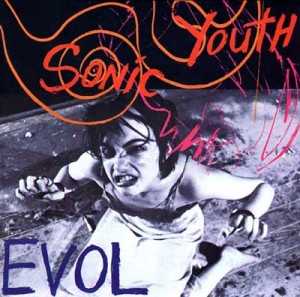
EVOL – SST, 1986
Highlights: “Tom Violence,” “Shadow of a Doubt,” “Star Power,” “Expressway to Yr Skull”
Low Points: “Death to Our Friends” isn’t necessary, but it’s not bad either
Overall: I haven’t stressed this point until now, but pre-EVOL Sonic Youth suffers from the “You had to be there” syndrome of certain groundbreaking art. Those early records were particularly exciting because they caught a genre in transition—moving away from prevailing contemporary ideas, pulling in outside influences, expunging tired clichés. 25 years later, the shock value of that movement is largely gone, but those documents remain. I can appreciate those albums for what they are—for the 2010 listening experience of Confusion Is Sex or Bad Moon Rising documented above—but I can’t fully appreciate what it was like hearing those albums in the context of 1980s underground rock. So much of what Sonic Youth brought into underground rock has since been normalized, so things like wonky alternate tunings (Polvo, ahem), prepared guitar treatments, drone-oriented soundscapes (Kranky Records), and postmodern nightmares (Godspeed You Black Emperor’s F# A# Infinity would be an apt companion piece for Bad Moon Rising) now seem strangely commonplace. I can’t blame Sonic Youth for their timeliness and innovation, but I can prefer the more timeless material those early experimental records evolved into, starting with this aptly titled album.
Bad Moon Rising demonstrated Sonic Youth’s newfound ability to shape their avant-garde influences into an actual album arc, but excluding “Death Valley ’69” and “Brave Men Run (In My Family),” its songs were still dominated by their experimental lineage and their confrontational stance toward rock and roll norms (melody, for one). EVOL opts to subvert from within by embracing shorter songs and memorable melodies, trading confrontation for listenability. Those elements still take a backseat to the creative approaches to guitar and song structures, but their presence helps EVOL tremendously.
I’ll hand it to Kim Gordon; barring the first 1:15 of “Secret Girl”—an unnecessary soundscape delaying the entrance of the disturbingly pretty piano part—her three songs on EVOL are all top notch. “Secret Girl” shows that ornate beauty can still be unnerving. “Starpower” limits the vocals, letting the disorienting guitar and bass parts dominate the song. And “Shadow of a Doubt”? I’ll be stunned if I come across a better Kim Gordon song on one of the remaining albums. The layered harmonics—pulled lower than usual thanks to those alternate tunings—would alone make for a wonderful song, but it’s Gordon’s alternately hushed and feverish delivery that sets the song apart, reciting the combination of sex and murder inspired by Hitchcock’s Shadow of a Doubt and Strangers on a Train. The intimacy in “Shadow of a Doubt” is truly impressive; even in a song about two films, there’s no distance between the Gordon and the subject matter.
Thurston Moore also has three excellent songs—the excellent opener “Tom Violence,” the woozily propulsive “Green Light,” and the notoriously great closer “Expressway to Yr Skull.” Moore opens the last with “We’re gonna kill the California girls,” but unlike the threats of violence on Bad Moon Rising, this sentiment is marked by its nonchalance. It’s supposedly about Madonna and Sean Penn, but the lyrics are so vague that any cultural criticism is effectively irrelevent. “Expressway to Yr Skull” is all about the rise and fall of its guitar-driven rollercoaster. After a few ups and downs, the final two minutes of ambient echoes closing out the album feel earned. (I know I vowed not to listen to the bonus tracks, but a few times the cover of “Bubblegum” has come up after “Expressway” and it’s unendurably terrible.)
Another strength of EVOL is how even its weaker songs aren’t particularly bad, they just don’t measure up to “Shadow of a Doubt” and “Expressway to Yr Skull.” Lee Ranaldo’s “In the Kingdom #19” is a poem about a car crash with Mike Watt on bass (shortly after the D. Boon car crash, even). Its engine-revving guitars are neat, but after a few spins of EVOL I’m tempted to skip it. “Death to Our Friends” is a decidedly competent instrumental. Moore’s “Marilyn Moore” is essentially one of the droning cultural critiques from Bad Moon Rising performed with the cleaner aesthetic of EVOL, but there are a few moments when the buzzing guitar noises gives way to an affecting calm.
I can appreciate Bad Moon Rising, but I don’t anticipate ever loving it. EVOL, however, floored me on the first listen and kept me coming back for more. I’m almost reluctant to move onto Sister, since I’d rather stick with “Shadow of a Doubt,” “Starpower,” and “Expressway to Yr Skull” for a few more days. For the first time in their catalog, there’s no need to reconcile the difference in eras. EVOL has lost nothing in the last 24 years.
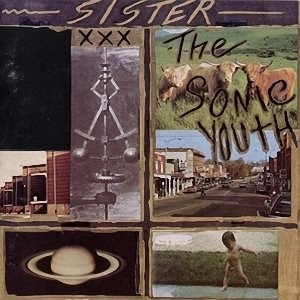
Sister – SST, 1987
Highlights: “Schizophrenia,” “Beauty Lies in the Eye,” “Stereo Sanctity,” “Cotton Crown”
Low Points: “Hot Wire My Heart,” the “Kill Time” part of “Pipeline/Kill Time”
Overall: The fundamental question about Sonic Youth albums changes with Sister. It’s no longer “Is this stage of their development interesting out of its historical context?” EVOL answered that one definitively. Now it’s “Is the songwriting on this album consistently good?” Sure, there may be a sharper change in the approach to the songwriting on a given album, presumably Dirty and NYC Ghosts & Flowers, but most of their avant-garde impulses will be pushed to non-album material from here on out, whether it’s the Ciccone Youth album, the Fall covers EP, or the SYR series of EPs. This divide maintains Sonic Youth’s experimental side (and their street cred), but it also means that their official LPs are now known quantities with a certain level of expected quality.
Sister certainly exceeds such expectations, both fitting into the prevailing sound of late 1980s indie rock and dictating what groups would rip off in the years to come. Virtually every one of these songs offers at least one of the following, if not all of them: a tricky verse guitar part; an insistent vocal hook; a mesmerizing noise bridge; a dramatically effective change of pace. If pure songwriting is the determinant of success, Sonic Youth nailed it. I spent far longer with this album than I anticipated, since every time I’d hear something new, some new song would stand out from the fray.
The majority of those highlights are Thurston Moore tracks, which vaults him to the top of the SY totem pole for this go-around. Although “Expressway to Yr Skull” is the most notorious song from EVOL, Kim Gordon contributed “Shadow of a Doubt”—its best song—and two other solid tracks, giving her a higher success rate than Moore. (Lee Ranaldo, buddy, you need more than one song to get in this fight.) This time it’s Moore with the tremendous success rate. Opener “Schizophrenia” is primarily a Moore song, a mid-tempo demonstration of their newfound melodic instincts and their invitingly warm guitar tone, but Gordon does appear midway through with a dreamy embodiment of the song’s titular theme. “(I Got a) Catholic Block” is a nervy post-punk song that covers a remarkable amount of ground in less than three and a half minutes. “Stereo Sanctity” features some excellent surf-inspired drumming from Steve Shelley, which forms a pounding underbelly for Ranaldo and Moore’s strafing. “Tuff Gnarl” wrote a good amount of 1990s indie rock with its opening verse (including at least one Rectangle song), but Moore doesn’t wear out its welcome, making the descent into noise even more noticeable. “Cotton Crown” is a Moore/Gordon duet—I’m surprised that there haven’t been more of these—that gradually twists its carefree lilt into the best noise bridge on the album. “White Cross” is one final blast of tricky indie rock to close out the album. Six original Moore songs (two with Gordon assistance), six winners.
Moore hardly has the exclusive rights to Sister, since Gordon and Ranaldo each contribute a great song of their own. Gordon’s “Beauty Lies in the Eye” is shockingly lovely, an even more drugged-up version of Mazzy Star’s desert shoegaze. Ranaldo’s “Pipeline/Kill Time” starts with two minutes of a downright boogie that easily makes up for the growing distance between his vocal performance and the increasingly melodic deliveries of Moore and Gordon.
There are a few slight issues. The cover of Crime’s “Hot Wire My Heart” gives some 1980s scene recognition to an early California punk band, but the song’s punk minimalism ultimately sounds too removed from the rest of the album. Making the song a b-side or hidden track would have been preferred. As much as I dig the “Pipeline” half of Ranaldo’s lone track, the “Kill Time” half does just that, wandering for about for two and a half minutes. Yes, it makes sense thematically in the song, but it takes away some of the momentum from “Stereo Sanctity” and “Tuff Gnarl.” Finally, Gordon’s “Pacific Coast Highway” is a love/hate affair; I love how they brought back the industrial nightmare of Bad Moon Rising with more focus, I love the switch to the floating instrumental mid-section, but I cannot stand how Kim Gordon says, “I won’t hurt you / As much as you hurt me.” Words cannot express how much her delivery of “me” irks me. If that’s the point, kudos, but that one syllable makes me itch to skip the song.
Sister lacks a definitive song like “Death Valley ’69,” “Expressway to Yr Skull,” or “Teen Age Riot,” but its consistency is remarkable, even with those minor missteps. It’s not the edgy early stuff, the first instance of excellent songwriting, or their double-album epic, but Sister’s comparatively less exciting dominant trait—being a great single LP—shouldn’t be undervalued. I suspect Sister will stick around my playlist for a while.
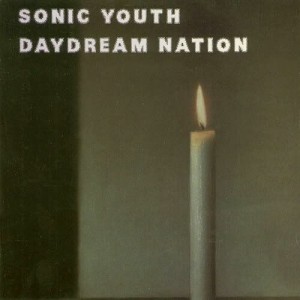
Daydream Nation – Enigma, 1988
Highlights: “Teen Age Riot,” “’Cross the Breeze,” “Total Trash,” “Hey Joni,” first two parts of “The Trilogy”
Low Points: “Eliminator Jr.,” “Providence,” lyrics in “The Sprawl”
Overall: Sonic Youth had certainly been important, exciting, and influential prior to Daydream Nation, but this album made them icons of alternative/independent rock. (That sentence was auto-completed by Microsoft Word once I typed Daydream Nation.) To put it in more personal terms, there was no debate as to the first Sonic Youth album to pick up when I was in high school. I doubt that I’d heard any of the album prior to buying it, even “Teen Age Riot,” because of my lack of indie-oriented friends, but I’d done enough reading to know which one to buy.
Being confronted with a double LP as my first taste of the group, however, seems foolhardy in retrospect. Loved “Teen Age Riot,” sure, but I could probably count my total spins of the entire album on one hand prior to this week. Getting stuck on a particularly great first track is a specific problem of mine (Rex’s Rex, Pinebender’s Things Are About to Get Weird), and the difference between the inviting riffs of “Teen Age Riot” and the dissonant propulsion of “Silver Rocket” was enough to make it happen. The latter features the noise bridge that so many EVOL and Sister songs utilize, but since I hadn’t heard those records, I couldn’t recognize that trick. Now that I can pick up on Sonic Youth’s structural tendencies, the album doesn’t seem so daunting. (I’m also thirteen years older, so I’d imagine that plays into it as well, but let’s return to the actual album.)
There’s no point to saying that Daydream Nation is great. It is. Any devil’s advocate arguments seem like pointless trolling. The most scathing criticisms (only 8/10 from Prindle!) I’ve found mention that a few of the songs don’t measure up to the highlights. I’d argue that it’s true, but ultimately irrelevant. “Eliminator Jr.,” the Kim Gordon punk conclusion to “The Trilogy,” is most frequently cited, but I don’t think its lady cock-rock is inherently bad, just a strange tonal switch following “Hyperstation.” The noise collage “Providence” is unnecessary, but reality check: is Sonic Youth really going to record a double album without including at least one formless noise collage? Come on. Fewer people critique Kim Gordon’s feminist, proto-riot grrrl lyrics in “The Sprawl,” but some, including myself, find them a touch tedious. Yet the song itself is great and most of it is instrumental. Finally, most “critical” reviews have issue with one of the three Lee Ranaldo songs, usually “Eric’s Trip” or “Rain King,” but I felt like all three of his songs are marked improvements over his past output, especially “Hey Joni.” On an album with fourteen tracks (counting “The Trilogy” as separate songs), two or three low points is expected. The overall quality remains superb.
The high points of Daydream Nation are almost unfairly assured as forward-thinking rock songs. The riffs feel more traditional, based more often on crystalline arpeggios and roaring chord progressions than the wonky noise leads that dominate those earlier records, but none of them feel dumbed down in the slightest. Even with its dreamy Kim Gordon open, “Teen Age Riot” never veers off course into a noise bridge. Prior to Daydream Nation, Sonic Youth reveled in those noise parts of the songs, even presenting them as the true attractions to the songs. This approach gradually evolved over the previous two records, but “Teen Age Riot” is when they recognize how great their hooks can be. Gordon’s “The Sprawl” and “’Cross the Breeze” each stretch out past seven minutes, but it’s hard to find a moment in “The Sprawl” when the melody isn’t floating along in its closing mist or one in “’Cross the Breeze” when its considerably momentum is completely gone. The beginning of “Total Trash” is so casually endearing, predicting countless Stephen Malkmus deliveries. “Hey Joni” is the relentless Ranaldo rocker that “In the Kingdom” and “Pipeline” could only hit at, choosing to accelerate rather than drift into aimless noise. The first two parts of “The Trilogy” cash in on the epic dynamics of “Expressway to Yr Skull” with even greater peaks and valleys. A few more songs merit mention as highlights, but that’s what happens with a classic double LP.
I keep thinking of Television’s Marquee Moon, one of the towering achievements of 1970s NYC punk, and it’s a telling, flattering comparison. Sonic Youth emerged from the fringes of this scene, initially embracing its more avant-garde tendencies, but the compelling lyrics and confidently creative guitar work on Daydream Nation refers back to that album’s combination of storytelling and songwriting. Sonic Youth took a strange, interesting journey to get to Daydream Nation, whereas Marquee Moon was Television’s debut LP, but each album manages to bring in the past, define the present, and look to the future. Daydream Nation is undoubtedly Sonic Youth’s greatest achievement. How many bands can pull off a double album with minimal fluff? Almost none. What about double albums that crystallize a genre and capture an era at the same time? Even fewer. Its monumental stature, however, doesn’t guarantee that it’s the best album to start with or that it will ultimately be your favorite Sonic Youth album. I may very well prefer Sister, since it’s simply easier to pick up and spin in the car, but that doesn’t take anything away from Daydream Nation.
Clcik here to read about Sonic Youth's 1990s albums
|

My long-overdue best of 2009 list is now up. You can sample these twenty fine records with links (YouTube and mp3) for songs from each album, or download the two-CD Recidivistic Best of 2009 mix, which, surprisingly enough, features songs from each of these albums.
The top five became clear to me by early November. Six through twelve were in consideration most of the year. Beyond that, it was a crapshoot. I considered including albums from Boston Spaceships, Constants, Do Make Say Think, J Dilla, Mission of Burma, A Place to Bury Strangers, Ring, Cicada (opted for Heroes of the Kingdom—more on that decision soon), We Were Promised Jetpacks, and Wye Oak, all of whom could have easily made it. There is a handful of great recommendations I’ve barely processed (including Floodwatchmusic’s number one, Blut Aus Nord), which may very well top a number of these albums in the near future. If I’ve learned anything about list-making, it’s that the finished product is always temporary. These are the twenty albums I’d recommend first if someone asked me today.
I’m still planning on doing a top albums of the 2000s list, but given the frequency with which my views change as I track down more great albums, it may be a while.
|
|

